#this is based on a panel from book four so that is in fact:
Explore tagged Tumblr posts
Text

I d ont want to work on this anymore you can't make me,, sorry LisIm nation-
#arm/hand. hurt. bad. taking bong hit shortly after queueing this to Relieve#anyway i wanted to do some lisim for pride. we've got a week left on requests as a reminder!#art icons fanfic ideas even.... any request will at least be heard! fics probably wouldn't be done before month's end but still#icons i can do Super Easy (especially if you have a specific panel or screenshot you want your character taken from)#art... might be more sketch stuff and probably not today. but I'm still Listenin!#i had some asks i wanted to get done ideally for june bc they'd be Funny but idk how well that's goin as a heads up#ooc#art#fanart#scott pilgrim comic#sp comic#scott pilgrim fanart#lisa miller#kim pine#lisim#ship stuff#lisa x kim#kim x lisa#scott pilgrim lisa#scott pilgrim kim#kim pine fanart#lisa miller fanart#spto#spvtw#spvtwtg#this is based on a panel from book four so that is in fact:#julie powers#scott pilgrim gets it together#anyway i stopped working on this bc i realized i was using the wrong brush. i have a love hate relationship w ink pen#signature ink/tattoo inker FOR LIFE
38 notes
·
View notes
Text
Doctor Strange's disability: a (much needed) chronological review
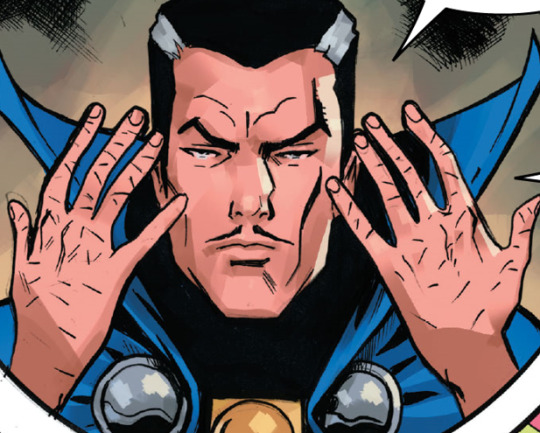
In view of recent ableism and drama on the other social hellsite involving Doctor Strange's disability, here's my response, based on *CANON* material. (link to the thread on said hellsite here)
Stephen disability is established since 1963, back in Strange Tales #115. The story is focused on a flashback which portrays his journey from the decay of his medical career because of a car accident to his path towards the mystic arts.
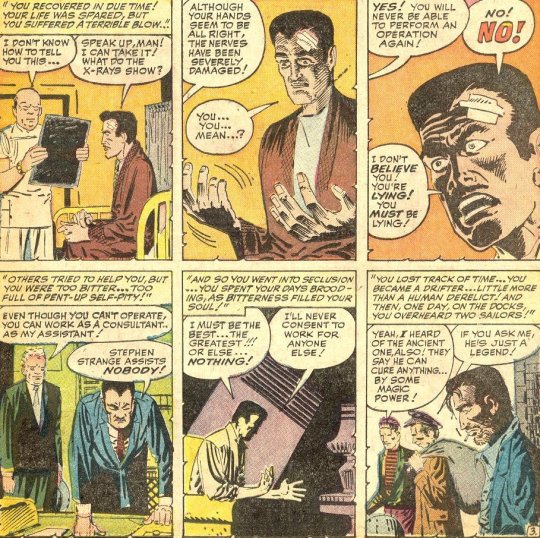
Note that, in this very same issue, the Ancient One never says he would heal Stephen's *hands*, but perhaps Stephen would find the cure within. In other words, Stephen was supposed to heal his heart and soul from arrogance and egoism through magic, not a physical cure.
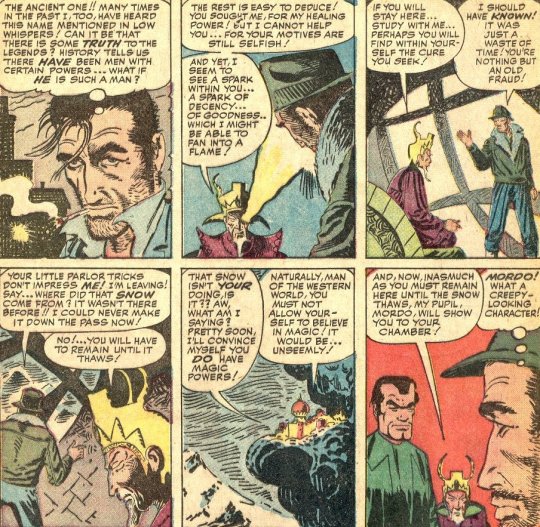
Also note that there are limitations within every aspect of comic books' universes. In this case, we're talking about magic. Magic is not a miracle thing. It demands training and, most recently as established by v4, a cost (Doctor Strange v4 #4).
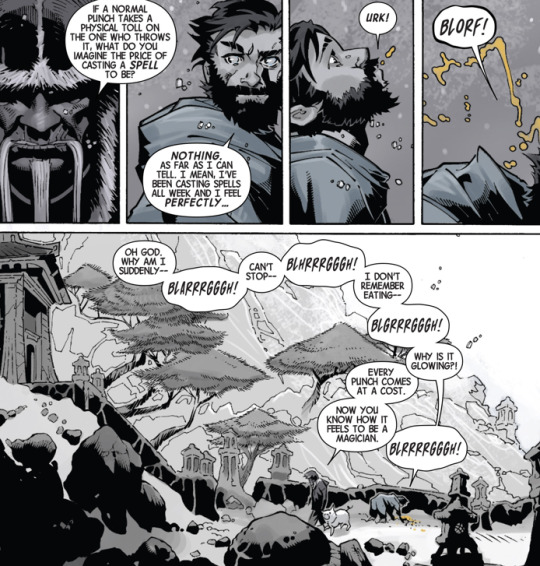
Another clue that "magic can heal anything because it's fantasy" is not a valid argument within Marvel's magic world, as seen in The Oath. Stephen had access to the Otkid's Elixir, which could heal any disease, but the formula was lost in order to save Wong's life.
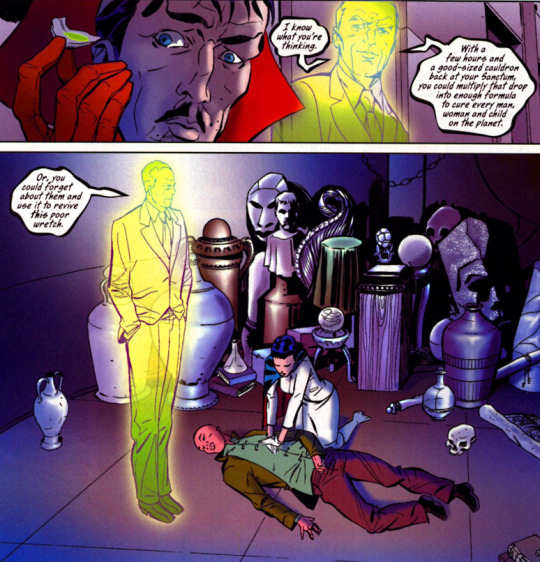
One last example comes from Spider-Man Family #5 (2007), featuring Morbius and Spidey. It establishes that healing demands the exact same price when it comes to magic.

Long story short, it's clear that the magic side of Marvel does not offer a solution to diseases through magical miracles. So this argument is totally invalid ~within~ this established universe.
Now back to Doctor Strange... No, he isn't using magic to heal his hands unlike some misleading accounts are claiming. In fact, there are several panels which show that he's actually in constant pain. Here's some examples:
- Doctor Strange - Sorcerer Supreme #48 (1992).
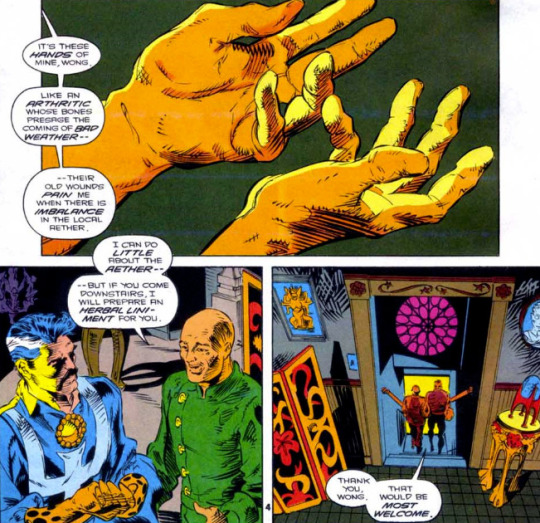
- Captain Marvel v10 #6 (2019)
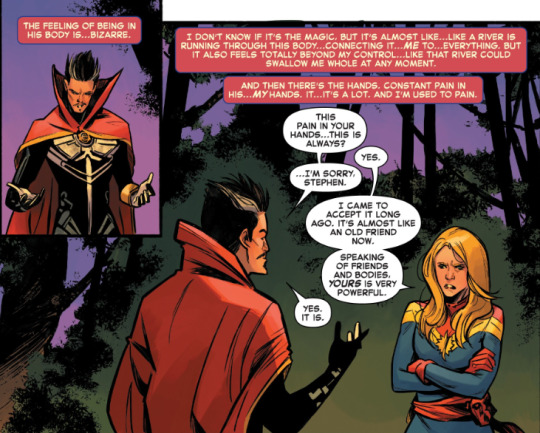
- Doctor Strange v4 #1 (2015)
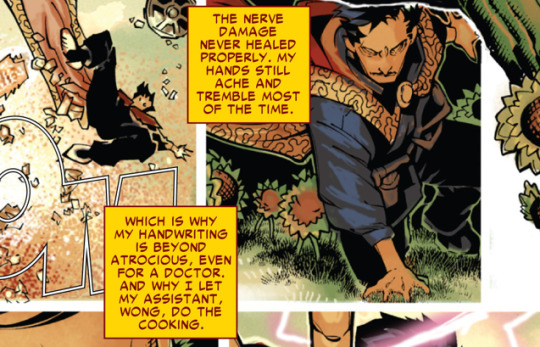
He also struggles to hold a pen and write, relying on magic to do so, as seen in the Book of the Vishanti.

Then comes the stupid argument I saw.
"Oh, but Google says his hands are healed!" is not a gotcha moment you think it is. We had FOUR MAIN BOOKS after that (Surgeon Supreme, DODS, Strange v3 and current v6). Allow me to clarify the details in chronological order.

Stephen indeed made a "magic" gamble and healed his hands. That much is correct. But it's not all (panels from Doctor Strange v5 #19 - 2019).
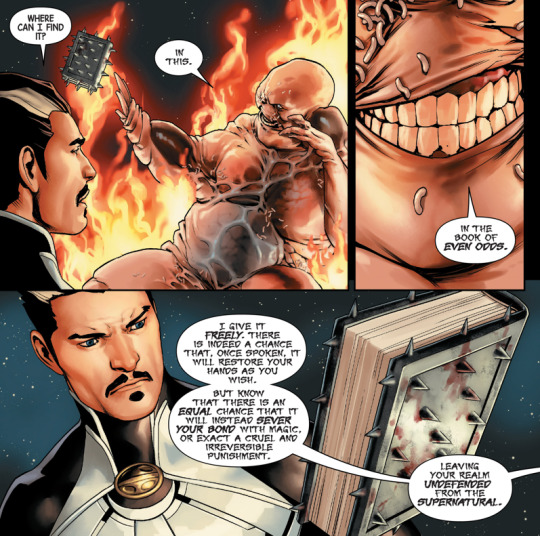

Waid continued this storyline in a new book called Dr. Strange (Surgeon Supreme), which would portray Stephen's duality as the Sorcerer Supreme and a brilliant surgeon. Except the book was cancelled at issue #6 (2020), leaving the character in a kind of limbo. Now enter MacKay.

MacKay kept a little bit of the former storyline as seen in Death of the Doctor Strange #1 (2021). On top of that, his hands appeared healed. However, that lasted only until Kaecilius murdered Stephen and stole his hands.
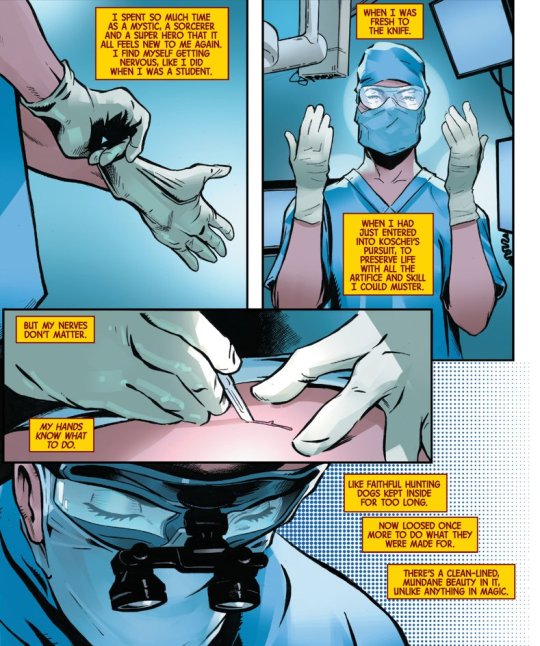
Stephen's temporal duplicate used a regenerative spell to bring original Stephen back through Kaecilius' body and the stolen hands. In here, we can see that his hands are scarred just like after the car accident (DODS #5 - 2022). OG Stephen died a second time with scars as well.
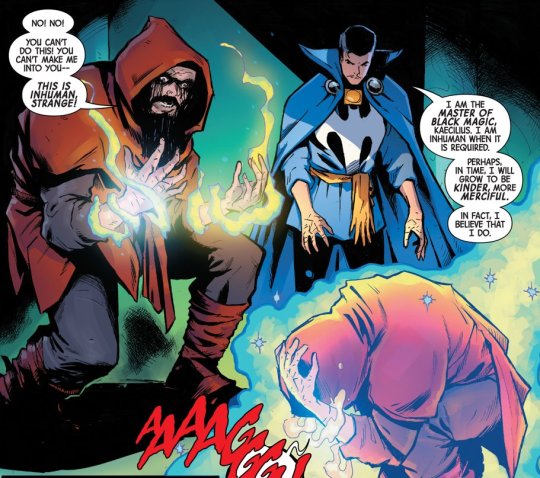
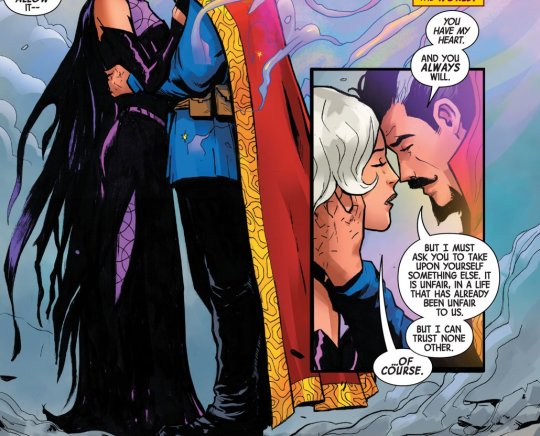
Stephen is indeed seen writing in v6 but it's not clear if he's using magic or not. Besides, he's not working as a surgeon anymore. Moreover, MacKay considers Stephen disabled as seen in this recent issue of v6 (#7 - 2023): "My own connection to the aether, the magic of the world, the power of the Vishanti, the power of the Sorcerer Supreme... Gone. Without all of that? I am just an old man with useless hands and a blade in his stomach."
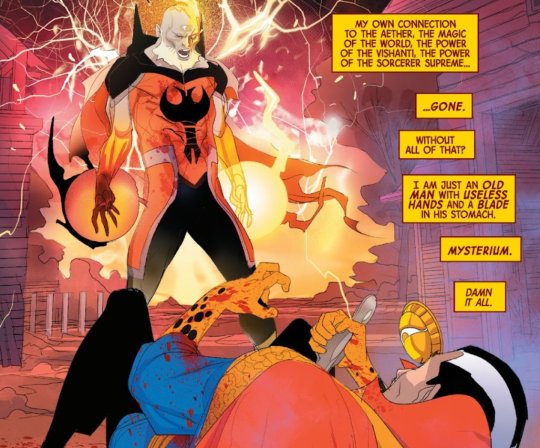
In conclusion,
As of CURRENT DOCTOR STRANGE RUN by Jed MacKay and Pasqual Ferry, in the year of our lord Vishanti, 2024, Stephen Strange is a disabled character and no magic or ableism will erase that. Thank you very much.
237 notes
·
View notes
Text
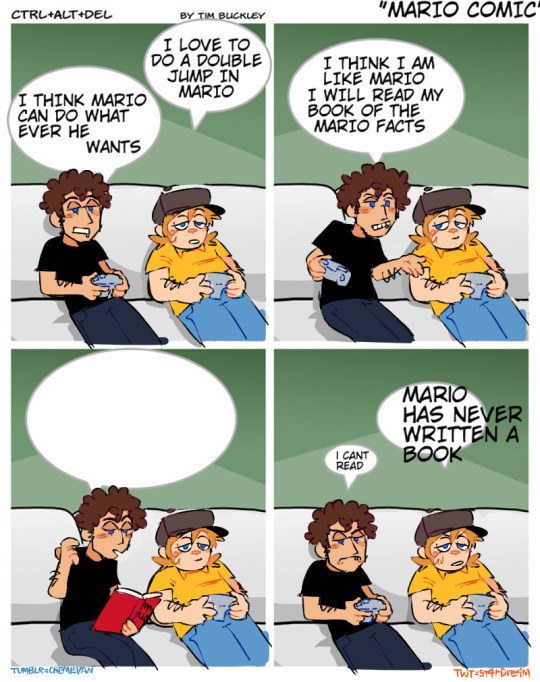
sorry for not being active on tumblr (or like social media in general) anymore take this nonsensical drawing as an apology
(based on this)
[Image ID: a four panel comic featuring joe trohman and patrick stump from fall out boy. on the first panel they're sitting on a couch playing videogames. patrick says "i love to do a double jump in mario. joe replies with "i think mario can do whatever he wants". on the second panel joe seems annoyed and says "i think i'm like mario i will read my book of the mario facts", while patrick looks at him. on the third panel joe has a book, and he just has a blank speech bubble over him. on the fourth and last panel they're both playing again like in the first one, but joe looks upset, saying "i can't read" and patrick answering with "mario has never written a book", and his text is way bigger than normal so it doesn't even fit the speech bubble./.End ID]
#fob#fall out boy#joe trohman#patrick stump#fob fanart#fob art#fall out boy fanart#fall out boy art#ctrl alt del#comic#fanart#my art#described
336 notes
·
View notes
Note
I find it interesting that Tsukasa reached for Nene without hesitation. It was probably because he needs her to fulfill his goals but I wanna be delusional and say he has a heart and cares for her / people
lol it is very hard to tell with tsukasa!! but he definitely does have a heart it’s just….selective lol.
and i think the fact that it's so hard to tell how tsukasa feels about people makes him and nene such good complements to each other!! nene is so expressive and open, and tsukasa is such a mystery to the audience and especially to amane, the person closest to him. these differences play off of each other beautifully. it's nene's openness and persistence and open-book optimism that gets us so many glimpses into tsukasa's feelings and past and world view and the different attitudes he's capable of embodying and expressing. and i personally think this moment is an example of that!
i think tsukasa catching nene was a very instinctive action he took!! i don't think he gave it any thought:


i loveeee this moment and these two pages like... he makes the decision so quickly that the panel of nene falling doesn't even have time to complete!! tsukasa physically breaks into the panel of nene falling, that's how fast and split second his decision is!! it's such a beautiful use of the space on the page. and tsukasa looks surprised by himself on the next page!! tsukasa is a very calucated person who usually has the upper hand, and in this moment he realizes he has truly given that upper hand and that foresight and that planning up, that he needs to resort to the last resort of calling amane for help. he resorts to what he sees as the impossible!! so i really don't think catching her was just part of the plan. there was definitely an emotional element involved there!!
i also think nene really has a knack for bringing out new sides of tsukasa. she's the reason he revealed that he's called for hanako before with no response!! she challenges him in ways he hasn't been challenged before!! she constantly surprises him and makes things interesting for him. i think she is definitely a very unique relationship in his life, and given all the reactions she gets out of him, i would say he definitely has at least some level of emotional investment in her as a person.
you are right though, that this doesn't necessarily mean he cares about her... but i don't think it's delusional for us to hope that it means something along those lines!! after all, they've spent a lot of time together leading up to this moment, and thanks to time travel, who knows how many interactions they've had that only tsukasa has experienced at this point? there's so much we don't know about tsukasa, constantly!! and i think the way he feels about nene is one of the more confounding mysteries about him.
i think it's very possible he has a soft spot for nene at this point! or at least is developing one. I’d believe it!! after all, if nene falls to her death who will listen to tsukasa talk about amane for four hours straight??
also look at them here:

serious analysis on pause they're best friends here. they are consulting they are looking to each other they are silently communicating!!! where do we go from here!!! nene said :0!!!!! tsukasa said O_O!!!!!
okay back to more text based analysis lol: from a different angle, you could also argue tsukasa's end goal with all of this is extending nene's life, as he's working to grant amane's wish, which, to his knowledge from the conversation in ch91, would be to extend nene's lifespan. so indirectly, but still supposedly his goal in a way!! which is a way to interpret his motivations in this moment as well.
and on the topic of tsukasa's goals, i think they show his heart!! yes, he's got an agenda, but overall his agenda has really just been to grant amane's wish. and it's an agenda he does his best to fulfill, which is a way of showing heart!! he thinks this is how amane can get whatever he wants. so in a way, even if this moment was just about needing nene as a means to an end, the end and the means of getting there are all motivated by his heart!!
but yeah in summary i definitely think there's a lot of depth to this relationship and to this interaction in particular. it haunts me constantly!! i love tsukasa i love nene i love the ways they play off of each other so much!! yes i'm biased because i would steal the moon from the sky for tsukasa and nene, but i really do think she makes him feel a lot!! whether that results in affection for her i think is beautifully complicated and unclear, and i can't wait to see their relationship progress throughout the rest of the manga!!
so i am with you in your delusions anon!! keep the faith!! i certainly will!! <3
#hello it's me <3 a professional tsukasa apologist <3#tsukasa and nene are everything. they are parallels they are foils they are linked inextricably through time magic#they are sacrifices they are doomed they will not go down so easily#they are so full of love and they WILL pelt hanako with it no matter what he has to say about it !!!#tsukasa kidnaps nene but she retaliates by making sure HE is stuck with HER#nene looks at tsukasa and sees him and responds to him as an equal in a way i truly don't think we see any other character giving to him#but that's a whole other post and i've already stayed up way too late talking about them lol#tbhk meta#tsukasa yugi#nene yashiro
48 notes
·
View notes
Text
HTTYD continuity: Are there two Hiccups?
First of all, thank you for all the likes and reblogs on my ‘there are two Hiccups’ post. It’s seriously blowing my mind how popular it is. So, if you read it and thought “what? There are two Hiccups?”
Well, no… but actually yes. I wasn’t being literal (I know, on the reading comprehension website? Shame on me), but the thing is, I’m actually kind of right? Just look at these examples from the wiki:
The entire series is based on the six main Dragon Riders moving away from Berk for over a year. However, in commentary, Dean DeBlois has said that they all lived on Berk between the first two films. The second film’s Art Book elaborates on this saying that they all had responsibilities on Berk which prevented them from leaving.
In other words, as far as Dean is concerned, RTTE never happened.
The series also focuses on the six main Dragon Riders exploring lands outside the Archipelago together, while both Dean and the second film’s Art Book state that only Hiccup and Astrid ventured outside the Archipelago as they were the ones drawing up Hiccup's map. The other four stayed much closer to Berk.
Again, we have a direct contradiction between what Dean claims happened pre-HTTYD2 in his (head)canon, and what we see in RTTE.
Numerous other "dragon riders" are introduced throughout the series, when the second and third films themselves stress how Berk is the only community who rides dragons. Dean elaborated on this during a convention panel explaining that that’s why Eret and Drago were so alarmed when seeing Vikings riding on dragons, and why Eret assumed Valka was one of them.
In an interview with the series creators Art Brown and Douglas Sloan, it was mentioned that the show was originally meant to have 4 seasons, spread out over the span of a year and a half, leading up to the second film. Following the many clues and mentions regarding the passage of time within the story, the last 7 episodes of season 4 were supposed to have happened during the same summer as the film. However, when seasons 5 and 6 were ordered into production, the show writers had to carry on with the timeline they had set up, which inevitably lead to the series continuing into negative time; going past the second film.
In other words, the last two seasons of RTTE aren’t meant to take place before HTTYD2 - they take place after it. If there’s better proof that RTTE is on its own separate timeline, I don’t know what that is.
The majority of film characters are portrayed severely out-of-character in the series compared to the films and film-verse media; most arguably Hiccup and Astrid. Aside from having similar appearance and even voices, their personalities and behaviors in the series portray them as drastically different people than their film counterparts.
I would argue that they are more in character during RTTE, especially Snotlout, the twins and Fishlegs. Isn’t it amazing what being fleshed out characters instead of comic relief can do? But there you have it. RTTE!Hiccup is portrayed as drastically different to his film counterpart. When push comes to shove, there are two Hiccups.
Or, you know, three, if we count the one from the books 😂.
Now if you’ll excuse me, I need to get back to lamenting the fact we live in the timeline where THW exists and not the timeline where the writers of RTTE were allowed to make a full length conclusion movie.
67 notes
·
View notes
Text
Bedknobs and Broomsticks and the Beautification of War and Witchcraft: Siana’s Panel Presentation
Robert Stevenson and Ward Kimball’s 1971 fever dream of a musical combines action and animation, war and witchcraft, feminism and effemination, and a classic Disney fantasy touch. Based on the books by English children's author Mary Norton, the story follows Miss Price, the town's "crazy lady", "spinster", and secret witch, as she takes in three young siblings displaced from London during World War II. The four join with scammer/magician Emelius Browne to search for a spell that could “end the war”. Let’s take a closer look!
Narratives and Myths: The Disney-fication of Witchcraft
Stevenson and Kimball Disney-fy witchcraft through Angela Lansbury’s character, Miss Price. Storytellers throughout history often present witches as antagonists or villains: Hansel and Gretel (1812), Snow White and the Seven Dwarfs (1937), and The Sword in the Stone (1963), to name a few. Of course, by 1971, people worldwide could associate “Good Witch” with Glinda (1939), but she was not a catalyst for similarly-natured witches. Miss Price embodies a sense of normalcy and country charm that makes witchcraft seem more like a hobby rather than an all-encompassing characterization of evil. More broadly, Bedknobs and Broomsticks presents magic as realistic, providing the audience with an “anything is possible” mindset.
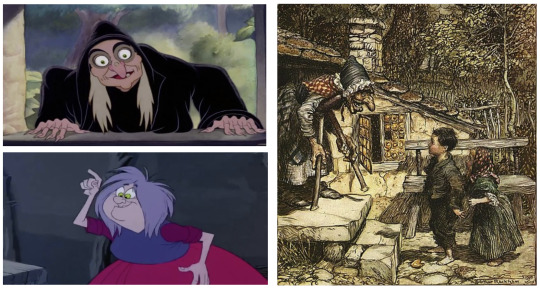
youtube
Depictions of Femininity and Masculinity: Just Feminist Enough
Being a witch simply slots into Miss Price’s identity: she is a single, private, middle-aged woman who lives alone in a large home fairly far from the town center. From our first encounter with her character, we can tell that she does not conform, and has no interest in conforming, to 1940s societal expectations regarding how a woman her age should present herself.
youtube
In her article “My Fair Lady: A Voice for Change”, scholar Marcie Ray notes that as America and Western Europe called in second-wave feminism, there came a filmic trend of musicals “[employing] the single girl character to depict the changing nature of (white) female sexuality” (293) as opposed to following a strict love plot. In a later section, “Eliza as the ‘Other’”, Ray discusses the tool of othering the lead female protagonist so she appears to have room for improvement, growth, and assimilation into proper society. Miss Price follows this formula, presenting palatable white femininity and feminism, but ultimately reverting to heterosexual expectations: Mr. Browne, once her anonymous professor of witchcraft, quickly becomes her love interest.
Aligning with the ongoing feminist movement at the time of this film’s production, Mr. Browne’s masculinity, and attached agency, come into question rather than being accepted as fact. His introduction in the film establishes him as a trickster, con artist, and coward. Miss Price turns him into a bunny multiple times, to which he replies “Miss Price, a word about your tactics: if I know I’m being changed into a hawk or a tiger, or something with a bit of flash, but always a fluffy white rabbit? It’s incorrigible!” This power dynamic cements Miss Price, and her playful, modern take on femininity, as the authority and lead throughout the film.
youtube
Class and Racial Subtexts: “Portobello Road”
The backdrop of World War II connects all the characters in this film through an environment devoid of abundance, and an expectation of having “less than”. Any hints of wealth or a British upper class can only be seen in what’s left behind during the height of the war rather than through individual characters.
youtube
The over ten-minute-long “Portobello Road” musical sequence demonstrates this time of unity through scarcity through color, music, and performance. The street, either through set building or editing, appears gray in itself and tinges everyone walking along the street similarly. This area of London feels communal and bustling while simultaneously being economically disadvantaged. The song, sung by all five of our lead protagonists and by the large ensemble, speaks of riches, fantasy, and possibility: the Portobello Road market is a symbol of hope, even if momentary and unfeasible.
There is little racial or ethnic subtext in this film - past, of course, the significance of WWII and all those groups ostracized, interned, and killed during the time. Portobello Road, however, curiously introduces a densely diverse enclave of London, including spotlight moments of Sikh soldiers, Scottish dancers, and Trini performers. Past their brief musical moments, we do not analyze or revisit these characters. We are, however, shown our five white protagonists interacting with these minority groups in a normalized, meaningful way: dancing, playing, and smiling alongside each other in this utopian street fair. This scene aligns more with the decade of the film’s production (late-60s and early-70s) than it does with the period in which it’s set (1940s).
Significance to the Audience and Temporality
As briefly mentioned earlier, the character development in Bedknobs and Broomsticks is critical to ensure the comfort of 1970s audiences. Miss Price is just feminist enough, the children as just boisterous enough, Mr. Browne is just crass enough, and everyone is just poor enough. There are many things a contemporary audience can problematize about this film: Miss Price’s reverting to patriarchal expectations of marriage, love, and motherhood; the romanticization of war and, specifically, WWII; Mr. Browne’s sexist remarks about women's memories and professional capabilities. At its core, however, this is still a Disney fantasy with loveable, quirky characters, catchy musical numbers, and an entire additional animated world to fall in love with. There’s a steadfast formula that makes this film enjoyable despite its generational immobility.
Critical Discussion Questions
How do we create lovable characters whose backgrounds are classically/traditionally/stereotypically rooted in horror, antagonism, and/or villainy (ex. witches, con-artists, monsters)?
What generational differences do you see embedded in your film / what changes should/would be made in a remake?
Are love plots actually necessary to the plot of your film or other musicals? What would look different about the trajectory and public reception of the film without a love plot?
@theuncannyprofessoro
20 notes
·
View notes
Text
Transformers: Mosaic - Fragments David Ellis
wada sez: Gather 'round, gather 'round, I have two more lost scripts to show ye. These were shared by David Ellis, who wrote just a single Mosaic to be released: "War Story". Not for lack of trying, though! It's shocking to me that nobody picked up either of these scripts, as they're both remarkably good.
"Hobby Time" (Bumblebee) [2010-09-21]
Panel One Iconic image of Bumblebee's robot mode as seen in the "--ation" trilogy. He's projecting a holomatter image of his holo-driver, the nameless hippy-chick female (and be sure to have her image flicker a bit so make it clear she's a hologram and not an actual human). The look on her face is inert; his is full of concentration.
(Also, leave room for the story's title and credits.)
CAPTION (Bumblebee's narrative): Holograms. CAPTION: For Autobots and Decepticons alike, it's functional.
Panel Two Cut to a view of Bumblebee's vehicle mode driving down the highway with the same holo-female at the wheel. Maybe show another car passing by, to get a sense of the Autobots being seen by others on a regular basis. In fact, would it work for the POV of this panel to be from inside some motorist's car?
CAPTION: It allows us to hide in plain sight on various worlds, without the natives wondering why we "vehicles" are moving around without drivers. CAPTION: Find a native, scan it, make a holo, and take care of business.
Panel Three Ideally, this panel should cover the width of the page. It's several versions of the same holo-female, each with a different outfit and hairstyle. The first could be her hippy-chick outfit as seen in the comics; another could be a Goth look; another could be a businesswoman, and so on. Heck, one could be wildly improbable like an heiress with a classy ballroom gown, or something from a Victoria's Secret store window (if that's not too risque), to show that while Bumblebee is aware of the idea of different looks on the same human, he's still experimenting and doesn't yet grasp the subtleties of fashion.
CAPTION: For me, it's something different. CAPTION: A fascination, for lack of a better word. CAPTION: The others don't notice, but I see so many different humans wearing so many different things. CAPTION: There's a point behind it; I know there is, and I want my holo-driver to blend in.
Panel Four We see Ironhide and Jazz watching Bumblebee as he crouches in a corner of their base, projecting his holo and looking for all the world like a boy caught playing with a doll. They look amused; he looks annoyed that they're teasing him.
CAPTION: The others are on my case about it. CAPTION: Prowl tells me not to waste energy on holomatter unless I'm on a mission. Jazz and Ironhide think it's funny. CAPTION: But they don't get it.
Panel Five Tight closeup of Bumblebee modifying the holo-girl's hairstyle. His face has the concentration of an artist's, as if this practice is fulfilling some inner creative need.
CAPTION: This war with the Decepticons leaves so much destruction and chaos, that it's a nice change of pace just to... CAPTION: ...create. CAPTION: And I find myself wondering...
Panel Six Cut to a police mugshot -- front view and side view, holding a nameplate in each one -- of a woman looking very much like Bumblebee's holo-girl, but she doesn't look much like the happy, idealized image Bumblebee carries around. She has a very weathered expression on her face, as she's not happy with the whole arrest-and-booking procedure; she looks like she's been through some hard living. The name and serial number can be whatever you want to put on there, just make it look like a convincing mugshot.
CAPTION: ...whatever happened to that human I scanned once? CAPTION: What's her life like? Is she anything like the way I imagine her? CAPTION: Maybe I'll find out one day.
END
wada sez: I'll be perfectly honest, David Ellis is clearly a cut above the vast majority of Mosaic writers. There's a few things here which make me roll my eyes—the rubbish title, the way it zeroes in on this one woman from Infiltration, and the twist of "aha, she was a criminal all along!"—but it's technically competent stuff that feels like it's engaging with actual human emotions through a uniquely Transformers lens. It's the idea of an image of a person as a proxy for the person themself; of idealising someone until the image becomes entirely divorced from the truth of that person. This is made more complex by the fact that this is also a form of self-actualization for Bumblebee; the woman he's fixating on forms the basis of an identity he is constructing for himself on Earth. The sentence "boy caught playing with a doll" evokes gender non-conformity to me—but on a much more direct level, I imagine many online Transformers fans would relate to this in the sense that we're all too old to be playing with toys, from a typical perspective. It's a story that invites interpretation and should resonate with people for different reasons, meaningfully building upon a minor beat from the official comics. For me, it's the final panel that really lets the script down—I think the dramatic irony of knowing the truth about the woman takes us out of Bumblebee's perspective without adding much to the story. Surely the tragedy here is that Bumblebee's life is so completely removed from human experience that he will likely never see this person again, and certainly never understand her! This next script is also thoughtful in its own way...
"Last of the Line" (Optimus Prime) [2010-09-21]
NOTE TO ARTIST AND COLORIST: This story takes place in the "Transformers: War for Cybertron" video game continuity. As such, all character designs and backgrounds should be noticeably in keeping with that game's aesthetic, with the exception of the last panel, which is '80s-era Generation One.
Also, except for the last panel, all characters should be in colors other than those we've come to associate with the canon characters. We're dealing with player-controlled character models from Team Deathmatch, explained here as other 'bots who walked off the same assembly lines as the characters we know.
Panel One Splashy panel of War for Cybertron's multiplayer Autobots charging into battle on the "Molten" map. We see a dark blue SPEEDSTER SCOUT (Sideswipe's body), a red INTERCEPTOR JET SCIENTIST (Silverbolt's body), a green DEFENDER SOLDIER (Warpath's body), and – most notably – a gold HEAVY RIG LEADER (Optimus' body).
The Leader is bolstering his teammates with a War Cry ability, so it'd be cool to see the glowing effect around the Autobots (likely via computer coloring).
(Also, leave room for the story's title and credits.)
CAPTION (Optimus Prime's narrative): This war has consumed our entire race. CAPTION: Not just as a collective…
Panel Two Reverse-angle shot of four Decepticons, toward whom the Autobots are charging. Bringing up the read is a CRUSHER SOLDIER (Brawl's body); leaping skyward is a STALKER SCIENTIST (Slipstream's body). Charging out in front are two ENFORCER SCOUTS (Barricade's body), distinguishable only by their differing color schemes. Most of the focus should be on the Enforcer Scouts.
CAPTION: …but as individuals as well. CAPTION: We are born on assembly lines, batches of us, numbering in the hundreds.
Panel Three One Enforcer Scout (#1) transforms into his car mode, while the other (#2), continues firing his EMP shotgun.
CAPTION: Hundreds of the same model… CAPTION: …but each one is distinct. ENFORCER SCOUT #2: Flank 'em if you want, but I like the direct approach!
Panel Four The Heavy Rig Leader cleaves #2 in the face with his Energon Axe, causing #2 to drop his shotgun. #1 can be seen in car mode behind Heavy Rig, peppering him with machine-gun fire.
ENFORCER SCOUT #2: Agk! ENFORCER SCOUT #1: Serves you right! CAPTION: Each one has become a fighter in this war…
Panel Five Splashy panel of the CRUSHER SOLDIER in the Autobots' midst, clubbing Heavy Rig and Speedster Scout with his Energon Hammer while using his Whirlwind ability.
CAPTION: …but some are better soldiers than others.
Panel Six Heavy Rig lies on the craggy magma ground, his armor shredded by Crusher's hammer. It's the instant before the Autobot explodes. Maybe include Crusher's foot in the panel as he walks over Heavy Rig's body.
CAPTION: Very few of us from ANY model line have survived to the present day.
Panel Seven Cut to OPTIMUS PRIME (the real one, not just a Heavy Rig), G1-style, set against an Earth backdrop, perhaps a forest of trees in the Pacific Northwest – as far away from Cybertron's Molten map as one could get.
His posture is contemplative, as if it bothers him how few of his kind have survived.
CAPTION: Hundreds of thousands of lives lost. CAPTION: Individual sparks extinguished. CAPTION: Leaving precious few to carry on the model line, and the Cybertronian race itself. CAPTION: I fear this war will lead to our extinction.
END
David sez: This one is based on the "Transformers: Warfor Cybertron" video game. It occurred to me that in a way all those multiplayer matches with player-created Transformers could actually be in continuity, since they're products of assembly lines. The multiplayer matches represent early skirmishes in the Autobot/Decepticon war, and that's why we haven't seen the countless iterations of the model lines that must have existed. They were blown to smithereenies.
5 notes
·
View notes
Text
I feel like Wally and Barry superspeed stress clean/organizing when they don't want to deal with anyone or are avoiding a situation. Kinda like how speedsters go into Flash Time or whatever it's called when they're panicking or trying to hide their feelings from their friends.
I see it being similar to the Young Justice comics (at least I think it was YJ, but correct me if I'm wrong) where Bart went into Flash Time ignored the other members of the Core Four when they came to see him, and was just... reading all the books in the library. Like my dude was so fast, they couldn't see him. You can get a better understanding of it from this post by @givemewallywestorgivemedeath where they have specific comic panels showing just how bad speedsters are at healthy coping.
Like imagine for a second that they do this. Barry Allen, at least my understanding of him which is partially based off a lot of headcanons (and projection but shush), is fairly organized. I think back to one of the animated comics (which might not be canon, I'm not sure but I liked the story) from a couple years ago, where he'd just come back to his job as a forensic scientist and was shoved into the archives for a while to organize everything. He seemed happy doing it, even using a little superspeed to hurry along the process. And I feel like a forensic scientist has to be somewhat organized and clean if they want to keep all the facts of a crime straight. I know it's a fandom (I think) interpretation that Barry takes cases when he's stressed to keep his mind off things, but imgaine him, when he's alone in the house and can't rant to Iris for whatever reason, he just goes full malewife mode and obsessively does a deep clean of the house, going as far as to reorganize the plates and glasses in the cupboards and taking meticulous care that it looks comepletly imacculate. Once he's done, he's probably hungry so he cooks himself a meal. He then has to put everything back in exactly the same way. Then he looks at the time, and knows Iris should be home soon, and speedruns setting up a romantic little date for the two of them.
And then Wally. There is no doubt in my mind that the man compartmentalizes everything. In the comics I don't think he's all that neurotic, but I still feel like everything has a place in his mind, however odd it might be. Especially when he was younger with the fab five. There was home, where he had to be quiet and obedient or else fear for his safety at the hands of his father, and his "job," if you can call it that, where he's a quippy extroverted kid. When he grows up, I think it starts applying more to time periods in his life than aspects of his present life. Most of it would be due to the overlap between his personal and superhero life, so it would be near impossible to seperate the two at this point. I mean, the guy works for his Justice League coworker when their both civilians, and one of his best friends, who used to be a super villian, works in the same building. Instead of a here and there situation, it would be a before and after. Before and after he got his powers, before and after he met Linda, before and after escaping the speedforce, and so on.
This might just be me projecting, but sometimes organizing or cleaning in one area of my life, can help make sure I can seperate everything evenly (for lack of a better word), and I can definetly see Wally doing the same, happening mostly before he got trapped in the speedforce when it was there vs here, but occasionally now when he gets overwhelmed. Sometimes when he stayed with the titans, they'd walk into the kitchen to see it comepletely reorganized. Sometimes Barry or Iris would visit him and see his room looking like it was a memorial rather than a 14-year-old's room that was actively lived in. As an adult he reorganizes and painstakingly cleans everything. Kids left their toys out? What are you talking about, they're neatly put in the bins like they should be. Stains on some the the clothes? Might as well do all the laundry. Oh, and don't forget to perfectly fold, match, and put them all away. Finished some leftovers and needs to clean the tupperware? No problem, while he's at it, he'll match the lids by size and reorganize the plates and bowls to save more room. Sometimes he completely changes the wat something is normally put away and leaves detailed notes to everyone who might, who just maybe, might have the slimmest possibility of being affected, telling them where he put everything.
Are they legible? Perhaps, on a good day. Probably not. It entirely depends on how he decided to write said notes. Did he decide to bullet point everything, skipping lines for each new point for visibility, or did he decide to write it like a fanfiction author who has never heard of an enter key? Does he use proper punctuation and grammar, or does he write like a seven year old during English? Is the handwriting even readable or is it just chickenscratch that only a pharmascist can read? Who knows? Wally West does what the vibes demand, and right now the vibes demand dyslexics to suffer! Or that a speedster halfway across the world responding to his stress and just perked up like a cat who has been awoken from a nap? Who knows? Not him! It's probably fine.
It was, in fact, not fine, as Linda broke into her own house instead of using her keys and speed talked at Wally to make sure her husband was okay. She then smacks him upside the head for making her worry so much.
#dc comics#the flash#barry allen#wally west#is most of this projection and headcanon?#absolutely#do I care? kinda#character analysis#-ish#this is probably ooc#but i think its a fun idea#headcanon
23 notes
·
View notes
Text
Ms Mystic #2 (1984)
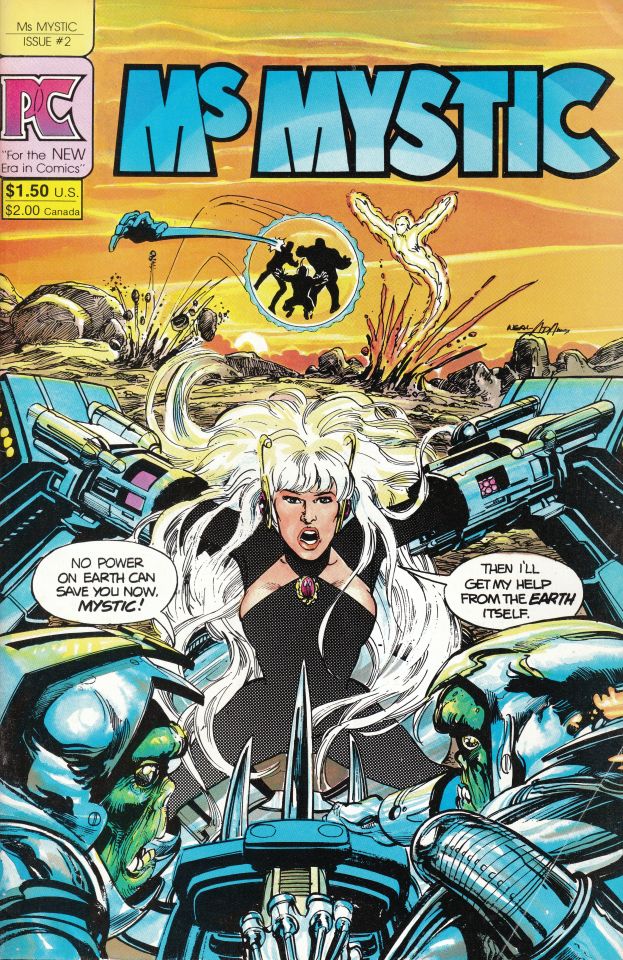
I bought this comic-book because of the Neal Adams cover. Nice surprise after discovering he is the author of interior pages also. Even not being a Continuity Comics' book, Ms Mystic is property or Adams, according the credits. In fact, it had a reprint/relaunch on Continuity a few years after.
The basic concept lies on a group of ecologist super-heroes. At the beginning of the book, we have a resume page that tells the story so far, more than enough to understand everything. We are in the middle of Ms Mistic (and friends) origin story: She comes from another dimension, brought to our planet by accident by a group of tecno-ecologist scientific warriors, while they were in the middle of a battle against the security forces of a specially toxic factory. The second issue starts with an inconscious Ms Mystic exploring the story of Earth in the astral plane. There, she makes contact with Mother Earth (really) and convinces her to provide elemental powers to the team, that is fighting (and losing) in the physical plane. Voilá: We have a full brand new super-hero team. The narrative/stylistic core of the book can be found in its central pages, where the events of physical/astral planes are narrated in parallel along double pages, dividing both narrative lines with a strong black line.
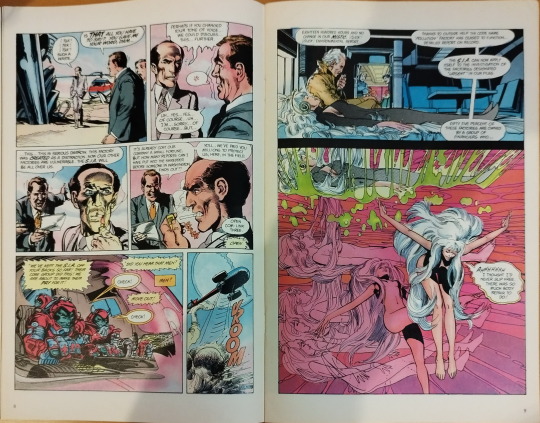
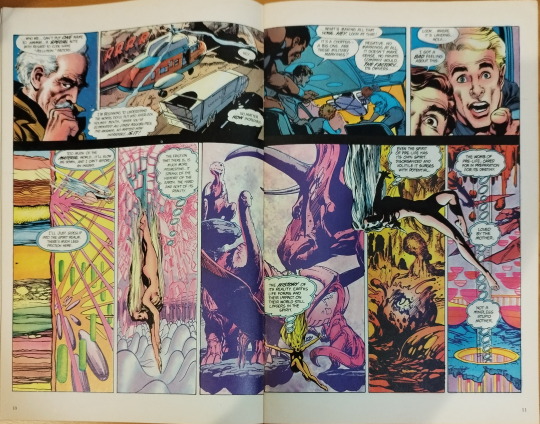
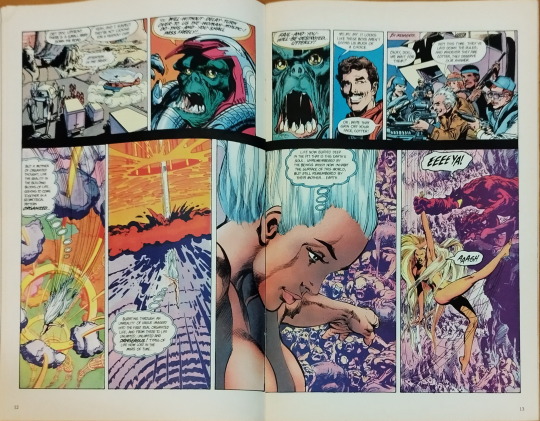
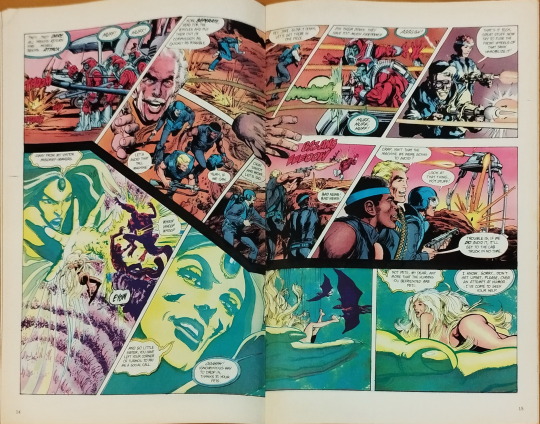
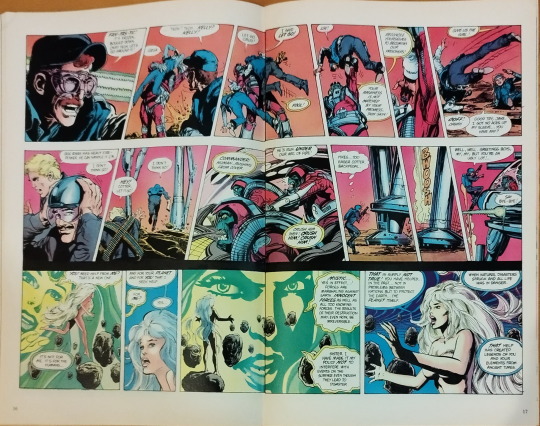
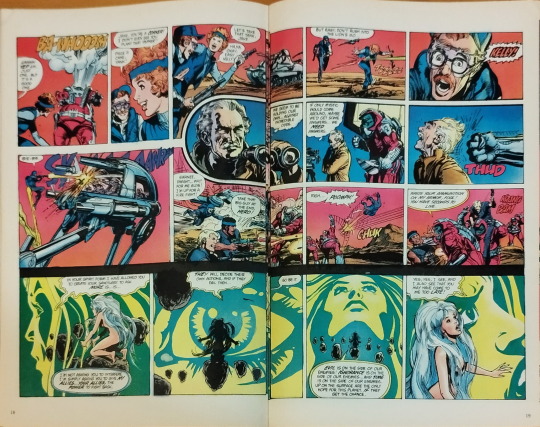
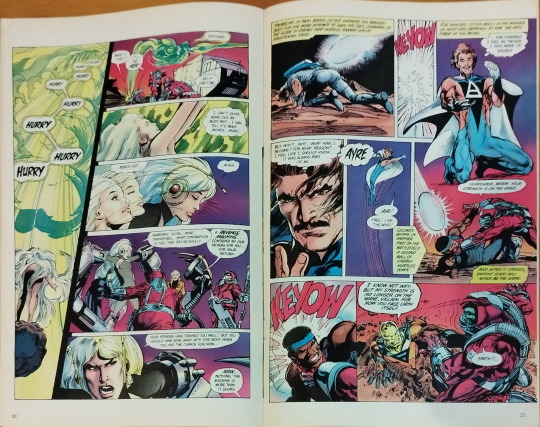
The astral section is based on a psychedelic near-Metal Hurlant imaginery, with our heroine naked but "convenient covered" in the fashion of Barbarella. Mother Earth looks like she comes from a Victor Moscoso poster. In general, coloring is outstanding in comparison with the average comic-books of that time, supported by a equally superior paper quality.
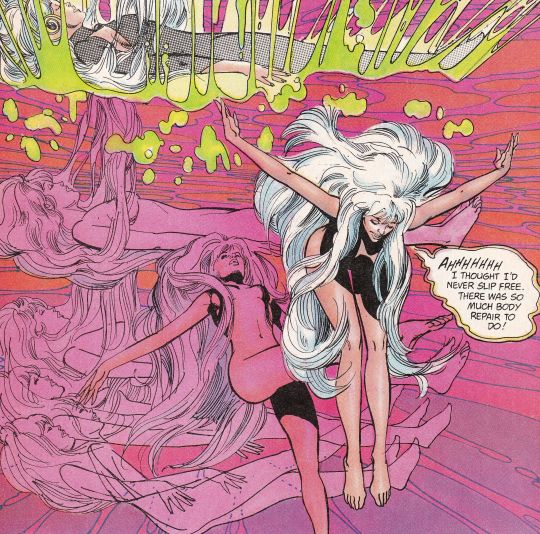
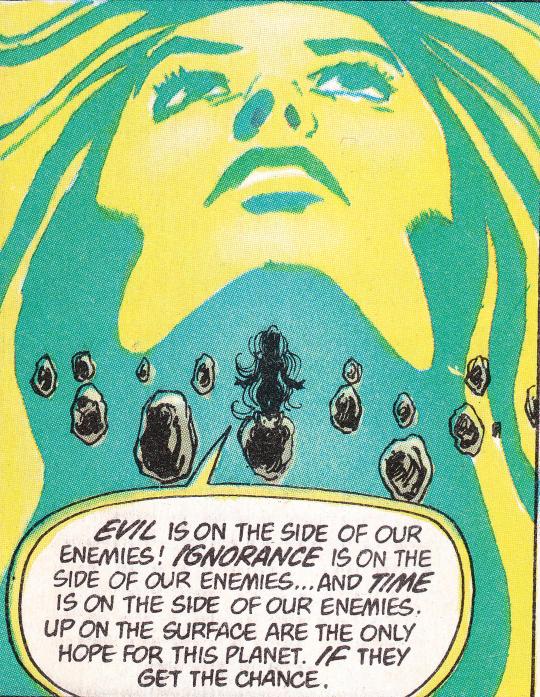
The physical battle section is more conventional, with a general design fully valid as base to create a toy line, with the homogenic super-hero team uniforms, the techno-monster evil warriors and action vehicles.
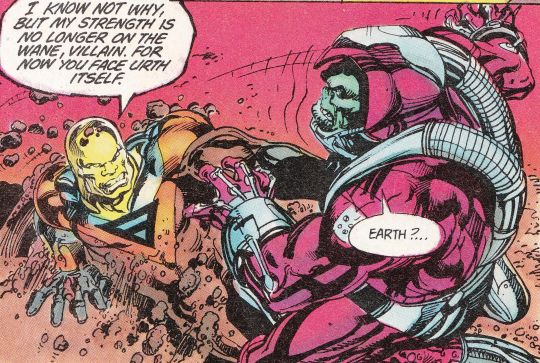
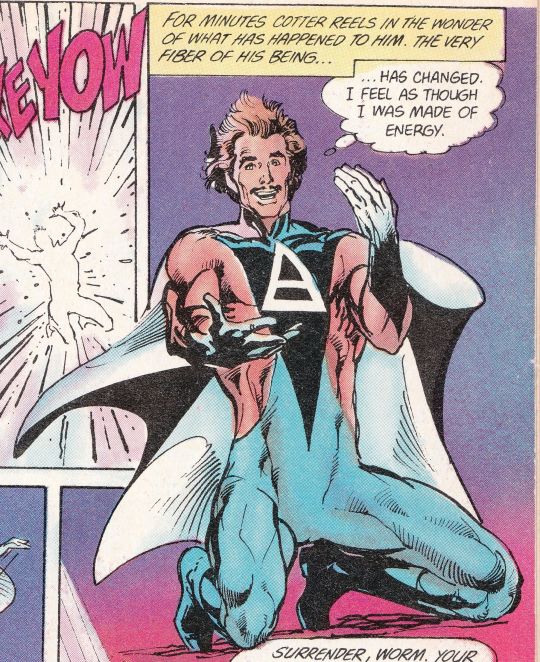
It's remarcable that, in oposition to other sensationalistic covers by Adams, this one reflects a literal scene of the interior. In fact, the cover is used as first panel on page 24. Also in the cover, we can watch a clearly intentional joke from Neal Adams, depicting the elemental super-team as if they were the Fantastic Four.

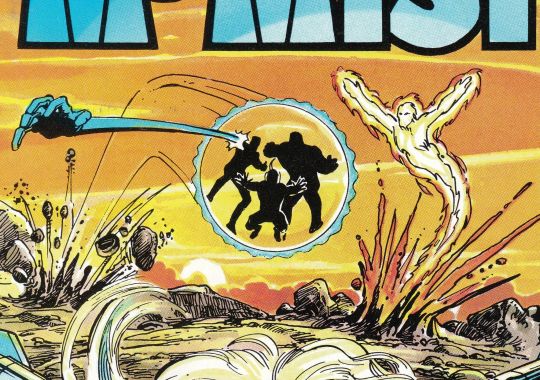
This second chapter of Ms Mystic finished in a thrilling way, with the main character cruelly impaled by the death device where she was restrained (it would not be possible in a Comics Code Approved book). I've had enough curiosity to look for the next issue on the Internet and dowload an old scan. I'm not going to spoil, but I can say that the #2 was the last one penned by Adams before passing his role to one of his clones.
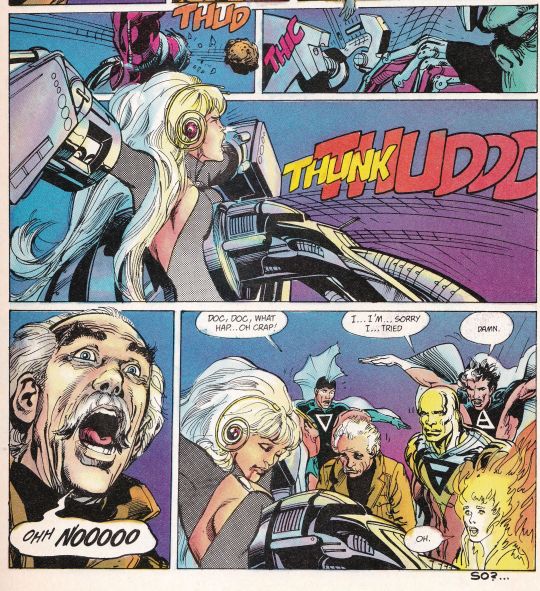
Purchased at Radar Comics (Madrid) for 2€
#Ms Mystic#Neal Adams#Pacific Comics#Continuity Comics#Victor Moscoso#Fantastic Four#comic-books#review#randomcomicbookreview
6 notes
·
View notes
Text
We're weird here, right? Yeah? Good. Let me tell you about the fucking MAGICAL narrative journey that is the CoD Zombies story. It's weird, it's jank as hell, and by the end it has me thinking seriously on the implicit meta-narrative to it. Also, the story ends like 4 separate times.
So we begin with CoD: World at War.
"Nazi Zombies", a minigame unlocked by beating the main story, where you get to feel more justified in sinking lead into a horde than possibly anywhere else in gaming, or life for that matter. Over the course of the original maps, the devs see positive fan response and put a little effort into it. We get perks, fancy technomagic laser guns and wonder-weapons, and even some characters and lore.
That lore, by the way, is "The nazis were experimenting on mysterious rocks that turned out to turn people into zombies. Then the zombies broke out. The end." Our heroes, meanwhile, are all simple as hell. A Japanese honor-obsessed samurai, a German mad scientist, a Russian whose only desire in life is vodka, and an ultra-macho rambo-esque American with an IQ only marginally higher than that of the zombies they'll be working together to slaughter. Basically, all stereotypes, but played for that over-the-top sort of comedy enough that I'll be generous and call them 'caricatures' instead. This group would eventually come to be called "Ultimis".
Call of Duty: Black Ops
Back by popular demand, is the Zombies mode, now no longer exclusive to the nazi brand of zombie, because the story's going international. This time, our heroes are going on a tour of WWII-era conspiracy theories. Ancient Vril mysticism, Shangri-La, nazi moon bases - basically the plot of Iron Sky 2. Simple, except not really, but definitely absurd in a fun, goofy way. Notably, the loading screens and advertising also framed these maps in a sort of "comic book"-y way, to help us understand the level of narrative consistency and complexity we'd be seeing here.
(Before continuing, by the way, we also have the absolute TREAT that is the map "Five". Seriously, go watch its opening cutscene, and then imagine those characters being your friendly voices for the duration of the game)
The critical thing here is that, while WaW had some "easter eggs", they were just cute little bits and bobs. "Interact with some rocks hidden around the map, play a song", stuff like that. But Black Ops easter eggs were something else entirely. Trying to explain these feels like explaining the conspiracy theories that inspired the maps. "Go stand on the floor panels to enter Eclipse mode. Then find the four wall-dials and set them to specific values. Now use the shrink ray on a specific rock, which you must then shoot around the map until it lands on the temple." Stuff like that. And even though nobody realized it until the end, they were all connected - if you do all the easter eggs leading up to it, then the Moon egg culminates in the mad scientist character taking over the zombie horde. And then you blow up the Earth.
That's right, they decide to just go flying beyond all chance of imagining this stuff was happening on the fringes of history, it was all-along the story of an apocalypse enacted by a mad scientist and his rival engineering events against him. The End. This was the BIG moment that grabbed the attention and imagination of me and others as a kid. It took Zombies from "neat" to "COOL", and, for better and worse, secured this storyline and style as the "zombies breadwinner" for several games to come.
Side note: I don't recall exactly when they did this, but at some point Treyarch's writers realized that it's maybe a bad look to have one of the playable characters be "'German scientist who helped create the Nazi Zombies", on account of, y'know, the fact that that makes him a nazi. So at some point they did that thing where they "soft-retcon" in some audio clarifying that actually while he was always a psychopath, he was only ever in it For The Science (tm) and it was actually his rival Dr. Maxis who signed his research team on with the reich.
I'm not sure if there's a term for this sort of the thing - when writers don't really retcon in the sense of overwriting previously established facts, but use "reveals" to try and overwrite the meaning of those previously established facts. Yes, technically that's what all good reveals do, but it's also obvious in times like these that there used to be a clear understanding of the lore on both the authors' and audience's parts, which the author has since decided they don't like and want to redo. "Oops, that previous evidence/event didn't count because of contrived circumstances you knew nothing about and could not possibly have guessed."
If I sound like I'm going off on a tangent, I want to be clear - firstly, this sort of practice always frustrates me, because it makes it clear that the author is readily willing to "cheat" in the game that is the communication of a narrative, and secondly because that's secretly what this whole mega-ramble is actually about.
Black Ops 2: We Care About The Lore Now
So, Treyarch wanted to do more Zombies, and they liked the vibe they had so far, so they decide to stay in the storyline that exploded earth. The characters - now a farm girl, a nerd, a hobo, and a schizophrenic guy, all American, all came off more annoying than the "comedic" take Treyarch wanted. This group would be dubbed "Victis", and not only were these characters poorly received, but the story itself would feel aimless. How do you one-up a grand master scheme and the apocalypse? What are our survivors even doing? Treyarch has our old mad scientist and his rival acting as voices in the Victis gang's collective head to try and vie for control of the zombies, and this story would ultimately culminate in one of them (based on player choices involving arcane steps punctuated by some oddly sexual ones) winning the power struggle, and either way, some type of "the world ends again", either with the mad scientist turning the world into his plaything, or (the canon ending) the rival scientist enacting some weird arcane collapse that will let him be with his daughter. Either way, we don't revisit this world again.
I specify world because the characters will return, and even in the same game, actually.
But first - in the middle of the Victis plotline we take a brief visit to Alcatraz for an unexpectedly great zombies experience that's entirely disconnected from either of the plotlines so far. I bring this up only for completeness sake, and for a point that'll hopefully become clearer later.
Anyway, we now return to our regularly scheduled zombie programming - by which I mean, a whole new experience, Origins, featuring "modernized", more tasteful renditions of our original Ultimis team. We're introduced now to a strong-but-disciplined American soldier, a now safely WWI-era not-quite-mad German Scientist, a world-weary Russian who uses alcohol to tastefully take the edge off, and a Japanese samurai warrior who's struggling with the decaying traditional idea of "honor" in a World-War 1 setting.
This "new" (yet chronologically older) variant of the team would be dubbed "Primis".
And this time the plot has them freeing the spirit of a young girl, Samantha, daughter of Science Rival Guy Dr. Maxis who we'd just seen end the world (twice) from some weird arcane trap on the battlefield "of the Great War" so she can go to a mysterious place called "Agartha". Also, the ending cutscene shows her and "Eddie" (who appears to be a child version of our playable german scientist) to be playing with dolls and action figures of the zombies and the playable characters - implying that in fact our whole storyline thus far was "just a game", and the shift of control over the zombie hordes in the first game to Edward Richtofen was in fact just "Eddie" taking his turn playing as the zombies.
It's easy to forget for those of us who've kept up with the story since this, but I cannot overstate how confusing this entire situation was to resolve from a lore perspective. Options were:
1: As implied in the cutscene, acktually "it was all just a game". The lore that players had worked hard to uncover was all, within its own canon, a game being played by children. This was wildly unpopular, but also quite possibly the authors' intended interpretation because in a very real sense, it all WAS a game, and the lore mostly WAS made-up by players out of scraps of lore they'd found.
2: Our four protagonists had acktually all met for the first time in WWI, then again incidentally wound up together again after un-developing as characters due to Magic Rock Exposure (tm) in WWII. Somehow the little girl freed in Origins and her dad whose brain got put in a drone during that process both get put back into their bodies, I guess.
3: It's all a parallel universe with its own separate continuity; the little girl and Eddie believe they're just playing games with toys when in reality they've been shipped off to copyright-safe-Heaven and "games with toys" is how they cope with the trauma of their zombie-filled lives.
BLACK OPS 3: MORE
So, Treyarch picks option 3. Makes sense, it keeps us gamers feeling like our investment was in something worthwhile and not arbitrarily patched together, while also allowing them some more narrative liberty. Easy, right?
WRONG
Rather than just roll with "We're doing zombies again in a newer, cleaner universe", they have to tie everything up ALL together. Our new plotline is that ACTHSDHALY the zombie-rocks came from a bunch of eldritch tentacle-creatures called Apothicons from super-hell. We meet Dr. Monty, who's basically like if Willy Wonka was actually secretly God who's trying to get the kids safe and sound up in heaven and the now eldritch-based zombies sealed back away.
We follow Team Primis as they go back into our first universe to harvest the souls of Team Ultimis (so, their own original souls) which will somehow allow them to go to I-can't-believe-it's-not-Heaven too. They go there, shit accidentally goes wrong when eldritch-satan breaks out, but the gang beats him up with guns and Monty is able to re-establish his perfect world.
Except, uh, he tried to delete the Primis crew while he was it it, but don't worry, that random moment in Alcatraz earlier was act[coughing fit]ally super-duper important and drinking the blood of those prisoners let out heroes survive! BUT ACTASKFHALY THIS WAS MONTY'S PLAN ALL ALONG and he teleports them back in time to fight in-
oh right so "the great war" from origins wasn't in reference to WWI, it was
actually
the site of The Great War between humanity and the apothicons, and Monty time-travels the crew back then to be the heroes of legend that set up Origins to happen, creating a time loop. Characters are, this whole time, saying "the paradox must be resolved" without ever explaining what it is.
But yeah anyway the whole ride this game leads to a big "it was all a time loop" cycle deal, and also the tone has slowly shifted from BO1 comic-style to something that feels more like an "Avengers"-style quiptacular with MORE budget, MORE stakes, MORE lore that actually isn't a good thing because the more lore they pile on the more twisted and absurd the story has to get and also it occurs to me that "going avengers" actually is kinda the natural conclusion to "being like comic books".
BLACK OPS 4: BUT WAIT THERE'S FOUR
So at this point, Treyarch and Activision in general are spending more focus on trying to figure out a new angle to Zombies, but nothing takes off. Infinity Ward's "Zombies in Spaceland" was a whiff, Cod:WW2's "reboot" of Nazi Zombies didn't stick, and their new "Chaos" storyline featuring mixed-religious lore was also met with lukewarm-to-poor response (sidenote here: now that we're in a proper era where it's common practice to ask "What if Ra punched Odin in the face while Ares watches" we really should establish a term for it, like "Mixed-Religious Combat" following the form of "Mixed Martial Arts).
SO They felt some pressure to go back once more to the cash cow what is their absolute mess of an "original" zombies story, now termed the "Aether" arc. They don't have many maps left to develop this but that doesn't stop them from opening the story again, and this time the writers have fucking HAD IT with this story so they decide it's time to fucking END it.
Here's your finale: Victis crew (the all-american team nobody liked) are back, slightly better written this time, on the map that had gone the longest without a remake (notably, in keeping with modern media practice, every zombies map from from the Ultimis-Primis plotline had been remade at least once by now), and they make a macguffin.
Then Primis Nikolai (the russian guy) uses it to wish a new, zombie-free universe into existence and sends the kids away into it.
Also he poisons and kills all of Ultimis and Primis. Then has the kids shoot him. THE ADULTS ARE ALL DEAD NOW AND THEY GOT BANISHED TO SUPERHELL WITH THEIR MULTIVERSE THE END. Nikolai gives us some lore mumbo jumbo about how the arcano-babble and the eldritch-babble had done some techno-babble that "bound the team's destiny forever to the apothicon menace", so that the only way a universe could ever be free of zombies would be for him and his friends to all die.
And the thing is, he's right. Because if you've followed this far, you're probably seeing a pattern: People like these characters, even in their worst-written moments, and Activision isn't going to just let that go unmilked. As long as there is any possible way for these characters to return, they'll be brought back and the lore is going to be held and gunpoint and forced to cook up a reason for them to be there shooting zombies. So the only possible way to let this tortured, tangled mess of a plot finally reach an actual ending is to kill its protagonists - and not just kill them, but write them off so conclusively that there's no chance of resurrection, no more alternate universes containing them, NOTHING. THEY ARE GONE. And true to the Homestuck-ass law that was inspired by this exact effect, the only way death can stick from a narrative sense is if everyone's death is either a Just end or a Heroic sacrifice to nobly ensure a better life For the Kids.
Samantha and Eddie (at this point nobody asks why Eddie even exists or what timeline these kids are from) are finally safe. The end.
COD COLD WAR THE STORY KEEPS GOING
As if to prove my point, Cold War Zombies picks up with a new set of protagonists... and an easter egg featuring the return of Samantha, now slightly more grown up, I guess, and also with superpowers? And then she flies around a bit, before finally heroically sacrificing herself out of the story for good. Eddie - now a full adult Edward Richtofen once more - is a "big reveal" in a cutscene afterwards, confirming that, in fact, there will be no peace fucking ever until every last character from this beautiful, twisted plot is gone.
EPILOGUE
And I want to be clear, it is beautiful. I wouldn't have followed it this far or spent two hours learning just how much I have to type about it if I didn't love every second of it, especially the seconds spent hating on it. I could, and probably eventually will write another essay at some point on how fucking much I love jank-ass "broken" things like this.
But for now, I hope y'all see my points here. It's this weird case you see happen every now and then where people just fall in love with their characters, and won't ever let go. Certainly doesn't help that the authors of those characters can't figure out how to write anyone else decently, but this is just one of many franchises I've seen where the unwillingness to let go of a fan-favorite leaves the plot tied in knots as it constantly has to try and present a NEW BIGGEST THREAT EVER that becomes a BIG DRAMATIC CONCLUSIVE FINALE that then needs even bigger contrivances to bring the favorites back.
It's done a fucking number on Halo's story, which is impressive because a lot of halo's core fans never even really consider that it has one. It's hard for me to talk about Halo here without thinking to myself "STOP TALKING ABOUT JOHN"
Same deal with Marvel, same with Homestuck, same deal in a lot of cases that I'm sure you're aware of too.
So as my closing thought and my reward to you for reading this far, here's some homework! What the fuck do you call these problems? What do you call it when lore starts to go sour because it's spent too long being about the same thing? What do you call it when fan demand forces writers to rethink their endings repeatedly? What do you call it when writers "cheat" their way around prior writing, re-contextualizing everything so much that it's hard to actually believe anything they say anymore and we're just left to sigh and feel odd relief when they say "Somehow Palpatine has returned" without further explanation because at least that means ONLY the ending of the original trilogy has its weight retroactively worsened?
#zombies#cod#call of duty#narrative analysis#overanalysis#idk#rule#i guess#ramble#rambles#E#this became about#media#like media in general I guess#thank you for reading
2 notes
·
View notes
Text
As a person diagnosed with a disease that causes brain inflammation, whose diagnosis was significantly delayed by a neurologist failing to pass along important MRI results - yes, this was infuriating.
I nevertheless ship Hannigram, for reasons I struggle to succinctly explain.
(I would say “brainworms”, but I now get a monitoring MRI every year, and my last scan was clear. Presumably, someone would’ve mentioned it if there were literal worms in there.)
More on both the medical angle, and the “why TF do I ship this??” angle, below the cut.
What it felt like to find out important test results were not shared with me:
It was a horrible gut punch. In my case, there was no malice - only negligence - but the result was that I had been walking around for ten years gaslighting myself that the worsening symptoms I was experiencing couldn’t possibly be what I originally thought they were.
I was mad, but also just devastated. It really shook my core sense of safety in the world.
It took me about a year to even start to kind of feel normal again, despite the fact that I was getting really good medical care in the wake of the error being detected.
Details of what’s portrayed in this episode that are just dumb (aka ✨pedantry✨):
My experience of actual medical testing and care around inflammatory autoimmune brain conditions makes me even more irritated by this plot line.
First off, the MRI scene. Like, perhaps it’s different in the states, but in Canada, MRI departments operate 24/7. I’ve had scans scheduled at 3am.
They will definitely set up an emergency scan for you if you have an emergent condition (I only waited four days for the scan that ultimately got me diagnosed), but there’s no way that they could just do an “off the books” unofficial scan with no one around, as is portrayed in the show.
Also, neurologists don’t perform the MRI. Radiologists do it, and then they send it to the neurologist to interpret.
Most importantly, you CANNOT move your head during a scan. There’s actually a little cushion in there that fits tightly around your head to stabilize it so you don’t accidentally move it, but they also will tell you to stay very still. One radiologist warned me to “breathe gently”.
In the show, you can see the plastic frame where the stabilizing cushion should be, but in the name of a cool shot, they’ve removed it, and Will Graham is just bobbing his fucking head like he’s in Night At The Roxbury.


I was so irritated I made a gif.
That scan would be unusable.
Also, the fact that Hannibal is able to correctly guess the exact condition Will has makes no sense. So many things could mimic those same symptoms.
To conclusive determine that what I had was MS, the following tests were done (within the context of the taxpayer-funded Canadian medical system):
1. Standard blood panel and urinalysis to rule out common infections
2. MRI
3. MRI with contrast fluid
4. Spinal tap
5. Seventeen additional blood tests
And they did all that despite the fact that I had a first degree-relative already diagnosed with the same disease.
Some people have suggested Hannibal made the diagnosis based on smell, but that is anatomically nonsensical. The brain is wrapped in a pretty thick membrane; aseptic brain inflammation would be not off-gassing from the skin or mouth like a stomach cancer, or arsenic poisoning.
Finally, the ease with which Hannibal is able to talk Dr. Dipshit into committing gross and easily-detectable medical malpractice makes no goddamn sense. It is perhaps the baldest example of the cynicism of the show’s writing - as I argued in another post, it portrays a world in which almost everyone is despicable.
If we rule out the possibility of literal brainworms, how the f*^% did I end up shipping these two?
As for how I ended up shipping Hannigram anyway - I think a lot of it comes down to the fact that as a former right-wing true believer, I am an expert at creatively misreading media.
When almost all of popular art has the theme “your beliefs are bad, and you should feel bad”, you learn to preemptively kill the author (death the author?) so that you can extract enjoyment from a work of art without reexamining your odious beliefs.
( See: Republican politicians using lefty protest songs at rallies. )
I’m no longer a conservative - I excised those brainworms about a decade ago, thank god - but the willingness to just arbitrarily toss out parts of a story that don’t suit remains strong in me.
Season 2 of Hannibal is quite good, and Season 3 (while objectively bonkers and very poorly paced) has some great character moments. Hannibal as a character becomes a lot more complex as he unravels.
This unraveling makes him a fascinating figure onto which to project some of my worst psychological tendencies - specifically, my tendency towards splitting (where I see the people close to me as either all good, or all bad, and for that perception can change in an instant). So that’s really interesting to explore.
It’s also probably a deliberate misreading of the text on my part, but there are quite a few parts in s2 and s3 where Hannibal can be read as straight-up delusional; and while I am sensitive to the fact that people with delusional disorders are far, far more likely to be victims of violence than perpetrators, I am also endlessly fascinated by the trope of “character looks back on his life, and sees a series of horrible sins he’s committed, whose damage to others cannot be undone; and struggles with how to cope with that.”
So in that context, giving Hannibal a deus-ex-machina of high-dose risperidone creates some fascinating narrative possibilities.
(This is probably something I enjoy writing because I spent 15 years being an obnoxious apologist for horrible right-wing politicians.)
I also just like the idea of Will taking it upon himself to kill this guy once and for all, and then not being able to bring himself to do it, and instead just keeping him captive and constantly wrestling with the question of whether he’s just being pragmatic about keeping everyone in the vicinity safe from his pet serial killer, or if he’s actually doing what he’s doing to passive-aggressively punish Hannibal.
There’s just so much there, thematically, that I love to play with.
hannibal lecter SLANDER rant [spoilers for 1x10]
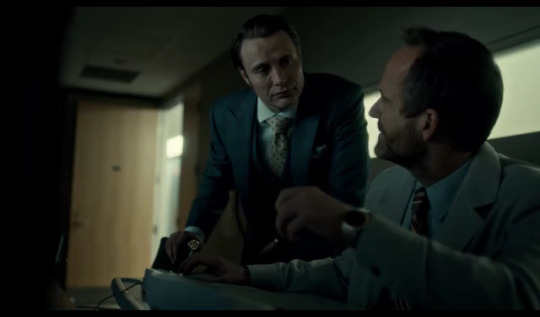
WHATTTT WHAT WHAT. Hannibal Lecter…Oooh… this just confused me so bad guys and when I finish the whole series and this whole rant turns out to be wrong I’ll admit it but how can you still sit there and ship hannigram!!!!! after this!!!!! it made me so mad that a LICENSED RADIOLOGIST sat there and lied to Will’s face ABOUT HIS OWN RESULTS because Hannibal asked him or whatever the fuck, I don’t know how close him and the doctor are yet or what their relationship is BUT???? LIKE???? He’s actively subjecting him to hallucinatory torture and the pain that comes with it, HALF. OF. HIS. BRAIN. IS. INFLAMED. HE CAN LITTERALY DIE FROM IT + brain damage, seizures, and worsen his already worse mental health. I HATE THIS GUY!!!! My hate train will start from here and continue on until he can prove me wrong
#hannigram#hannibal themes#hannibal meta#hannibal lecter#will graham#hannibal fanfiction#will graham’s encephalitis#mri#hannibal#hannibal nbc#nbc hannibal#murder husbands#brain worms#hannibal brainrot#hannibrainworms#< I will make this a tag goddammit
34 notes
·
View notes
Text
HYPER-DURABLE CARBON FIBER WALLET WILL MAKE YOU DITCH THAT TERRIBLY OLD LEATHER BI-FOLD
HYPER-DURABLE CARBON FIBER WALLET WILL MAKE YOU DITCH THAT TERRIBLY OLD LEATHER BI-FOLD
There was a time when “money” meant physical valuables. Belongings, jewelry, and coins made of precious materials like gold or silver. In this pre-cash era, it made sense to use a leather pouch to carry your items. As we moved to banknotes as currency, the flexible leather bifold wallet still made sense. BUT… we’re now 250 years past the Industrial Revolution, so why are we somehow still clinging to this prehistoric ancient material for making our wallets?Get more news about Men's Wallet Carbon Fiber,you can vist our website!
A dominant part of our financial institutions are now online, with more people using cards to make payments than actual banknotes and coins. This transition also demands a cognitive shift in the definition of what a wallet should be… and what it should look like. The Masverano Wallet is a part of that global movement towards a new future with a better wallet. Crafted from carbon fiber with a durable plastic chassis underneath, the Masverano hopes to be everything you’d expect from a wallet of the future. It’s sleek-looking, strong, spacious, lightweight, functional, secure, and uncomplicated.
The Masverano wallet’s design is simply a modern classic. It isn’t ancient, like your leather or fabric bifold, it isn’t overtly complicated like some over-engineered modern-day wallets we see today. It cleverly holds your cards between two robust carbon fiber plates, blocking them from view as well as RFID-protecting them. Your cards stay concealed, as does your cash (unlike modern money clips), and you don’t really need to struggle with mechanized triggers and spring-loaded deployment systems that deploy your cards in a fan-shaped pattern. You’re a classy urban citizen, not a street magician.
The Masverano wallet’s simplistic approach is clearly visible in its design too. The wallet is broadly made of four parts – two high-quality 3K carbon fiber plates, a PA 66 plastic frame, and a silicone band holding the entire thing together. On the inside, it has space for as many as 8 credit cards or a combination of credit cards and business cards, and a crawl-space built into the plastic frame in the middle easily allows you to store banknotes, coins, or even a key inside. Your cash stays hidden inside the wallet, and can be accessed on command. Easy peasy.
The beauty of the Masverano lies in the fact that it draws a fine balance between being modern and traditional. It reinterprets the wallet’s design and function for modern times, but still functions somewhat like your standard wallet by opening like a book to reveal what’s inside. If you want to access your cards, you can either open the wallet and grab the card you need, or slide your thumb into the notch in the carbon fiber panel to push your cards out and pick one, or simply tap to use it at a payment terminal.
By virtue of its sandwiched design, your cards and cash get conveniently segregated. The cash sits right in the middle, fitting into the cutout in the plastic chassis, while your cards get divided by the chassis into two zones. You can either divide your cards based on how often or rarely you use them, or by the type of card, be it a payment card, an ID card, a public transport card, or a business card.
0 notes
Text
NTT Trigon Writing Guide
Trigon, at the surface, is a pretty basic character, and even when you go deeper, that mostly holds true. However, there are a couple quirks that I feel are important to capture while writing him to keep him interesting and in character. This guide is focused primarily on NTT Trigon, but also works for pretty much any other comic book version.
1) Trigon Sucks
The number one character trait and the thing almost impossible to get wrong: Trigon is literally the worst ever. He’s committed practically any atrocity you could imagine with no remorse. His entire existence is based solely in absurd, total evil. Imagine your shitty dad (or a friend’s if you don’t have your own) if he was also a genocidal maniac and you’re already well on the right track.
2) Trigon cares about Raven
The only thing that even vaguely contradicts his seeming hatred and indifference towards every living thing is his daughter, Raven. He’s shown multiple times to care about her well-being, kind of (not wanting her to die is already a huge step up to how he treats most living things) and desperately want her to rule beside him.
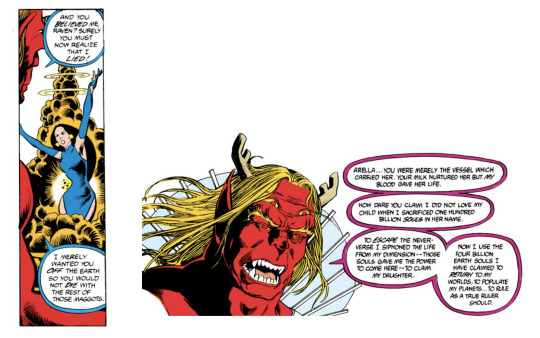
[Image ID: two panels of Trigon from the New Teen Titans. The first one, from NTT vol 1 #6, has Trigon saying to Raven “And you believed me, Raven? Surely you must now realize that I lied! I merely wanted you off the earth so you would not die with the rest of those maggots.” The second one, from NTT vol 2 #5, has Trigon saying “Arella... you were merely the vessel which carried her. Your milk nurtured her but my blood gave her life. How dare you claim I did not love my child when I sacrificed one hundred billion souls in her name. To escape the neververse I siphoned the life from my dimension--their souls gave me the power to come here--to claim my daughter. Now I use the four billion Earth souls I have clamed to return to my worlds, to populate my planets... to rule as a true ruler should.” End ID]
3) Trigon is a terrible father
(TW: mentions of child abuse in this section)
Just because he loves Raven doesn’t mean he isn’t terrible to her. Remember, Trigon is the literal worst. He loves Raven because he sees her as an extension of himself and the only other living thing worthy of a modicum of respect because she’s his daughter. He sees himself as having ownership over her due to the fact that he created her.
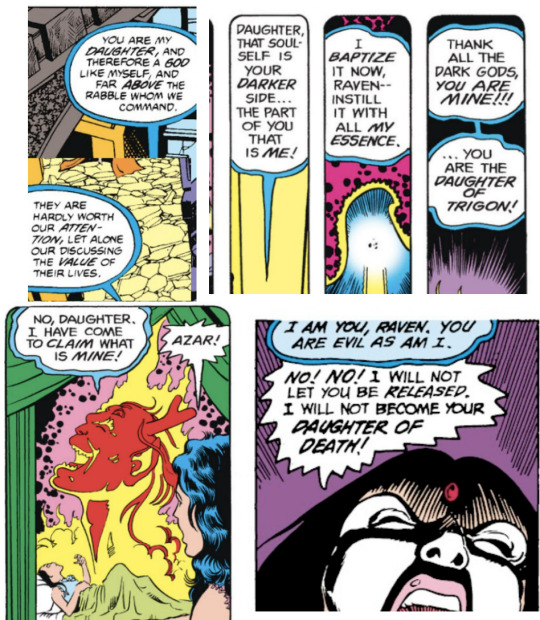
[Image ID: a collection of panels from the New Teen Titans. The first one, from NTT vol 1 #6, are two panels of Trigon speaking, one saying “You are my daughter, and therefore a god like myself, and far above the rabble whom we command. They are hardly worth our attention, let alone our discussing the value of their lives.” The second is from Tales of the New Teen Titans #2, also of panels of Trigon speaking, saying “Daughter, that soul-self is your darker side... the part of you that is me! I baptize it now, Raven--instill it with all my essence. Thank all the dark gods, you are mine!!! ...You are the daughter of Trigon!” The third is also form Tales of the NTT #2, of a vision of Trigon in Raven’s nightmare saying “No, daughter. I have come to claim what is mine!” and Arella, looking on at the scene, saying “Azar!” The final panel is from NTT vol 1 #25, and has a bubble of Trigon saying “I am you, Raven. You are evil as am I.” and Raven responding “No! No! I will not let you be released. I will not become your daughter of death!” end ID]
When Trigon realizes that Raven won’t passively put up with his cruelty or join him willingly, he begins sending her nightmares and mentally torturing her for months until her sanity crumbles. Even before then, he does things like punishing her by killing a child in front of her (NTT vol 1 #6) and physically torturing her until she admits that she’s his daughter (Tales of the NTT #2).
I think he does know that he’s treating her badly, but simply doesn’t care because he believes it’s his right. I think he also believes Raven would be happier ruling beside him and giving into her true nature vs trying to be a hero. Having him be too uncaring towards her (eg viewing her as disposable or trying to kill her) is out of character, but so is him being too nice to her.
4) Misc
Just like Raven, Trigon has an unnatural, kind of formal way of speaking.
Trigon is shown to be very manipulative and is capable of acting charming to get what he wants (eg making Arella fall in love with him).
Trigon is really old. It can be fun to keep that in mind while writing him.
In NTT, Raven is Trigon’s only living child after over a hundred failed attempts, which I think makes her even more special to him.
Trigon canonically has a dog in NTT vol 1 #6. Not that relevant, but I think it’s fun to bring that up.
In conclusion, Trigon really isn’t that complicated. Just imagine the worst thing he could possibly do/say in whatever situation he’s in and having him do it will usually work.
108 notes
·
View notes
Text
Behold - Assassination Classroom Iceberg

This is just my opinion obviously, and things I thought were kind of relevant. Explanations below cut!
Tier One
Shounen Jump - the weekly manga magazine Assassination Classroom originally was published in Yuusei Matsui - the series creator Nagisa's gender - in reference to the amount of people who think Nagisa's a girl for some period of time
Tier Two
Ramen gun meme - a viral tumblr post using the clip of Gastro preparing ramen with a gun which blew up far outside the fandom Koro Q - The fantasy chibi spin off manga and anime Manga only villains - Numerous characters (usually assassins) who only appeared in the manga 365 Days - The movie, featuring adult Karma and Nagisa remembering their days in class Toonami rerelease - Recent broadcast on an anime channel which has caused a sharp increase in new fans
Tier Three
Live action movies - two movies adapted from the ass class story Kunudon - the nut mascot of the school. Featured in weird BDSM situations within Koro Q Sonic Ninja - movie (loved by Karma and Nagisa) in the series. Has a whole trailer post credits in one of the episodes Nagisa's gender (controversy) - in reference to the portions of fans who fetishize him, write him as a female etc., and the fans who push back against it Pop culture references - numerous references to other anime like One Piece, Naruto, etc., but also other properties such as Pirates of the Caribbean Asano's mother - a character who barely exists aside from one manga panel, where you can see her back
Tier Four
Mobile game - a card collecting app/game where multiple illustrations of all the characters were released. No longer running. 3DS game - game based on the main story. Wasn't released outside of Japan nor translated Korotan - four book series for teaching English, but also included short stories. Most significant is Korotan D, which features the kids after graduating high school 7 years later manga - a number of short manga pages featuring a few characters in the future found in the Graduation Album. Karma discourse - never ending internal fights about whether Karma is a good person or not, especially over his Nagisa jokes
Tier Five
Korosuu - similar to korotan books, but focused on maths. Less well known due to incomplete English translation (i know im still working on it i swear-) Everyone owns the mountain - lesser known fact that E Class used their money to legally purchase the 3E class building and mountain Hachiouji - the real life city Kunugigaoka is based on Korosensei's nationality - more so because it's unknown, though there are a lot of fan theories OVA - an adaptation of the Kyoto arc before the anime was made, featuring a different voice cast and art style
Tier Six
Yada is LGBT - it's subtle but this is canon, and so she's the only definitively not straight character in the series Bonus songs - the releases of the OPs came with some bonus tracks sung by the cast (you can find them on spotify) "half middle two" - the worst translation in the series, of Karma's codename. It was meant to be a reference to the cultural phenomenon of a teenager living in a fantasy world where they're the best at everything. The shed - cursed location (i.e where Irina gets 'helped' by Korosensei) Timeline - for Aguri to have been the 3E teacher, the school year has to have lasted more than a full year Takada and Tanaka - two bully characters often seen from main campus. Weirdly implied to be gay for each other.
Tier Seven
Fuwa meta - Fuwa often breaking the fourth wall (esp in the manga), and implied to be the writer of Koro Q Bitch Sensei and Karasuma's daughter - Introduced in the seven years manga, but a lot of people missed that they have a canon child Kayano's dad is evil - a theory but with decent proof that Aguri may have been somewhat forced to marry Yanagisawa
Tier Eight
Commodore Matthew Perry - the historical commodore who came to Japan in the 1800s and forced the country to open up borders for trade (basically one of the most important Japanese historical events). In the manga, his image is shown when Bitch Sensei is teaching how to seduce foreigners. Karasuma's dead sister - referenced on the ass class wiki, with little explanation or general fandom knowledge as to who, how, or when Kayano pregnant - a theory some fans had due to the positioning of her hands in the final manga chapter
113 notes
·
View notes
Text
No, Re-Destro Is Not Destro’s Literal Son
and
Yes, I Will Die On This Hill
I have a number of small, persistent quibbles with some of the widespread misapprehensions I see included in BNHA fanfic, quoted as fact in meta posts, even cited on the wiki. Quirk cancellation restraints, what the 20% quirklessness data point means in practice, when Kurogiri comes into existence relative to the time of the Shimura Family Massacre, things like that. My biggest one, though, is as the title suggests: the idea that Yotsubashi Rikiya is Yotsubashi Chikara’s son.
I don’t entirely know where this confusion comes from. As far as I can tell, the early scanlations didn’t get it wrong—one rendered the line in Chapter 218 about Destro having a child he didn’t know about as being children, plural, but otherwise, they were all accurate enough. It seems people just assumed that the child mentioned in 218 must be Re-Destro, who was, after all, right there on the panel. Even though the scanlations never said it, even though the official translation never said it, even though ample evidence in the manga disproves it, the idea still got around that Rikiya is Chikara’s son.
I have and will maintain that this is obviously wrong if you stop to think about it for even a moment, but unfortunately, most people don’t. The error can be found on less well-tended parts of the fandom wiki[1]; it’s in tumblr meta posts about the villains; it’s in fanfic.
And now, god help me, it is on the official anime website, too.

“Stillness-in-green, maybe you should consider that you might just be wro—”
I will face BONES and walk backwards into hell.
But if you want, you can come with me, and I’ll explain on the way. Hit the jump.
Dialogue + Narration
There are two places where the relationship between Chikara and Rikiya is explicitly addressed—the lead-in to the dinner scene in Chapter 218 and the fight between Clone!Shigaraki and RD in Chapter 232. If you include the Ultra Analysis databook, the number goes up to four: once each in Re-Destro and Destro Classic’s character blurbs.
Let’s take a look at each of those places, shall we?

The relevant Japanese text here is in the first narration box: 子ども, kodomo.
Kodomo is not gendered. It literally just means child. The key kanji is 子, ko. Like most kanji, it has a lot of potential readings, and you can add other kanji to it to modify it. Add 息 and you get musuko, son. Pronounce 子 as shi instead of ko, and you get a term that is frequently, though not exclusively, used to refer to boys. Add 女 to that reading and you get joshi, woman/girl. 子 is in a lot of words, many of them gendered! Used for kodomo as Hori does here, though, it does nothing to indicate a gender one way or the other.
Also too, it does nothing to indicate that Rikiya is the child in question; it simply states that there was such a child, somewhere in the world. Now, the natural assumption for anyone who knows how the graphic novel medium works and who understands basic literary analysis would be that the significant character we just met is, in fact, the child in question—except that everything else we learn about Destro and the original Meta Liberation Army here makes it entirely impossible.
I’ll do a full breakdown on why that is in the next section. In the meantime, here’s the next reference:

Here, we’re looking at the phrase the Viz translation renders as, “His blood runs through these veins.” The literal Japanese there is, Desutoro no matsuei chi o tsugu mono! In a literal translation, chi o tsugu mono means, “one who inherits the blood,” or, more loosely, “blood successor.” It’s matsuei—末裔—that’s the key word here.
Japanese has several words to express the concept of “descendant.” Matsuei is one word; the data book uses shison. So what’s the difference? Well, I’ll talk about shison in a moment, but I had an inkling of it just from looking at the kanji in matsuei—“end” and “descendant” respectively, leaving me with an impression of something like a final descendant or the terminus of the bloodline. Further research confirmed it: shison can refer to any lineal blood tie, but matsuei refers to a bloodline’s final inheritor, the person at the end of a long line of many, or even countless, generations. It’s the difference between being able to point to a grandparent and the kind of painstaking genealogical research that lets you[2] point to a famous royal from eight hundred years ago—matsuei is a word that very much assumes the existence of those countless generations.
So not only does Rikiya’s line there not imply that he’s Chikara’s son, but his specific word choice also tells us that he cannot be Chikara’s son. That’s, uh. Pretty conclusive, I would say.
Lastly, though, there’s also the data book. This is, perhaps, the actual closest you’re going to get to a manga equivalent of those character blurbs on the anime website, at least until such time as Hori deigns to give the MLA types character profile pages. (I live ever in hope.)
There are two relevant bits of text, one in Re-Destro’s entry, and the other in Destro Classic’s. The first describes how Re-Destro organizes the MLA as Desutoro no chi o tsugu mono: the same phrase he uses for himself in the manga, minus the matsuei. @codenamesazanka (the one who told me about the databook references among other citations, bless) rendered it as “Destro’s blood successor”; I have also seen it given as “the successor of Destro’s bloodline.” Note again, the lack of reference to a father/son bond.
Chikara’s entry uses that other descendant word I mentioned before, 子孫, shison. Notice that the term uses that ko kanji from kodomo before? As it does in joshi, 子 here reads shi. The other kanji, 孫, means grandchild. Thus, literally, grandchild-child—or, in the vernacular, simply descendant.
And then we have the anime website.

So, for comparison’s sake, the anime website uses 息子—the same combination of kanji that I said earlier gives you musuko, son. Heck, it even uses 父, chichi, for Destro—father. It’s as explicit as it’s possible to be, and I just don’t know why or how the anime website could fuck that up so bad when absolutely nothing in the manga describes the two Yotsubashis that way, and, indeed, one specific word choice actually rules out the possibility.
So, that’s all the manga says directly. It’s not the only evidence there is, though. In fact, the next piece makes it even more clear how colossally and impossibly wrong a father/son connection for Destro and his modern successor is.
Timeline
The long and short of this section is, “Since Harima Oji was Sako Atsuhiro’s great-great-grandfather, there is no possible way that Destro—who pre-dated Harima—can be Re-Destro’s father.” If you read that sentence and nodded your complete understanding and agreement, feel free to skip ahead to the last section. If you’d like the full explanation it takes to reach that sentence’s conclusion, though, read on.
So, aside from the word matsuei, the timeline is the most telling piece of evidence to my eye. I address it secondly rather than firstly because it’s less direct than the explicit narration; it relies on drawing conclusions based on things we’ve been told elsewhere rather than on the immediately relevant text. Oh, Mr. Compress’s relationship to Harima is explicit enough, but on what am I basing my claim that Destro predates him?
Regarding that, there’s no explicit year relative to My Hero Academia’s current events given for when Destro and the original Meta Liberation Army were active; the same is true for Harima Oji’s escapades. However, we are given some broad-strokes information, relative not to current events, but rather to the history of heroism as a legal institution in Japan.
We know that there was a widespread, lengthy period of chaos following the rise of quirks—called meta-abilities in those early years. At some point, however, people began to search for a way for meta-humans to live in peace with non-metas. The compromise that was reached was the foundation of professional heroism in Japan—while the use of meta-abilities would be legal in private settings, it was only by becoming licensed by the state as “heroes” that people could use their quirks in public.[3]
The legislation curtailing the use of meta-abilities—and the appropriation of a dead woman’s language to popularize a law establishing exactly the opposite of what she used that language to call for—is what catalyzed the rise of the original MLA. Thus, we can position Destro as being alive and active around the same time that heroism as a legal institution was being formed. Since we further know that he committed suicide in prison, we can assume that his child was conceived at some point prior to his capture. Ergo, Destro’s child, were they alive today, would be as old as Japanese professional heroism itself.
Next, consider Harima Oji, the Peerless Thief, a criminal who targeted the riches of “sham heroes.” We’re specifically told that he was active in the days in which the current system was settling into place—e.g. he only became active once the Hero System was established enough to have produced corrupt heroes. We’re told he preached reformation—he wasn’t just some pre-existing criminal who saw a shiny new target in heroes; he had specific grievances which he wanted addressed by the system, and which the system was not addressing.
The earliest Harima could possibly be active, then, is concurrent with Destro—Harima fighting against the corrupt people who had found their way into the new heroic institution, and Destro fighting against using the institution of heroism to oppress non-heroes. What I think is more likely, though, is that Harima came after Destro—Harima needed to have had time to realize what kinds of fakes had been drawn to this shiny new career path, maybe even to spend some time trying to change things the legal way.
I don’t suspect they were separated by very long—I would imagine Destro was easily within Harima’s living memory, and might well have influenced why he chose the path of protest that he did—but I do think they were separate.
Moving forward, then, Mr. Compress is four generations distant from his famous ancestor. Thus, even if you assume that Harima is of the same generation as Chikara, that’s what you’re looking at for Chikara’s child: someone who, were they alive today, would be old enough to be the great-grandparent of a thirty-two-year-old man.
Re-Destro’s probably a few years older than Mr. C, sure,[4] but that man doesn’t have Ujiko’s slow-aging quirk. Unless you want to start pulling theories about cryogenic stasis the story for some reason never saw fit to mention out of thin air, Re-Destro is in no way old enough to fit the bill.
This is backed up by one other piece of the timeline as well, and one more place we can look at language:

The small child at the center of the image is Rikiya, so young that he’s in schoolboy shorts for a meeting otherwise so formal that he’s been made to wear a tie. He’s, what, six to nine here, tops? And the adults speaking to him say that they’ve been in hiding for generations—代々, daidai, the kanji for generation followed by a kanji that just means, “See that kanji written right before me? Yeah, just read that one again.”
The original MLA was active for only a handful of years, and, per Chapter 218, they didn’t dissolve until Destro was captured. Thus, we can assume they have been in hiding since then, but not before then. With that in mind, this is another line that renders a father/son relationship impossible.
Remember, Chikara already had a child in the world circa his capture. If Rikiya were Chikara’s son, then Destro’s capture and his army’s subsequent dissolution could not have happened any farther back than nine months plus however old Rikiya was in this exact moment of his youth. Rikiya, who we see here as a child of less than ten.
Ten years in hiding doesn’t make one generation; it damn sure doesn’t make multiple ones.
Now, you could make theories about cryogenic statis that would explain this ludicrous discrepancy, sure. You could also theorize about e.g. artificial insemination,[5] or time stop quirks, or any number of other possibilities in the vast panoply the HeroAca world offers. The point is, though, that you don’t need to. There was, in the manga, no discrepancy that needed to be explained. It is only fanon misinterpretation and a glaring disinterest in the series’ villains from official sources that have presented this issue.
I’m praying that it’s all just a misunderstanding on the part of whoever maintains the website, and that the anime itself will render the relevant bits of dialogue correctly. Given the extreme cuts and alterations that My Villain Academia has been subjected to thus far, though, I’m sure you can appreciate my being concerned.
…So that’s the meat of it. The idea that Rikiya is Chikara’s son is wrong simply on the basis of what’s said in the text, and it’s doubly wrong on the basis of the timeline. There is, though, one other thing I think points towards Re-Destro being exactly the descendant he says he is, not a son playing down the connection out of humility or something. This one is a lot more headcanon-y, though, so I saved it for last.
MLA Social Dynamics
It’s quite simple. We have, in the MLA, a group of people that venerates Destro’s bloodline to an obviously unhealthy degree, putting up portraits of him wherever they can get away with it, tagging his successor with a “Re-” as if to invoke reincarnation or miraculous return, entirely willing to throw their lives away for what they think was his cause, and others’ lives if those others say anything too scathing about the words Destro wrote, quite as if they treat Destro’s memoir as some sort of holy writ.
They venerate Destro that much, and you’re trying to tell me that they wouldn’t just call a spade a spade and acknowledge RD as the son of their great leader? Come on.
Since long before I turned up the matsuei factoid in researching this piece, since long before Mr. Compress gave us such a helpful generational comparison, I’ve held the opinion that, given a group that holds their leaders in such high esteem, with such particular regard for bloodline, the only reason Rikiya does just call himself a descendant, rather than citing the specific term for what he is, is that the specific term is distant enough that it actually does sound more impressive to just say “descendant,” rather than something like, “great-great-great-grandson.” That kind of thing just begs the question, “What took you guys so long?” or, “You and how many other people, buddy?”
Mr. Compress may have the panache to carry off a line like that, but Rikiya’s a different story. If he had something so amazing up his sleeve as, “I am the son of the great Destro,” I have to think he’d just say it proudly, not fall back on the impressionistic vaguery of something like chi o tsugu mono. Even if I had no other evidence to work with, I’d think the same—all the evidence you need is right there in the character writing of who Rikiya and the MLA are and how they talk about the man whose dreams Re-Destro was raised to carry.
A closing note: I will allow that Rikiya is being overdramatic when he uses matsuei and its connotation of countless generations. There are a few other things we can use to trace the history of heroism—Ujiko’s age, and the 18-years-or-less periods that One For All was held by its pre-All Might bearers—and running those numbers leads me to believe that it is, in fact, entirely possible to count the number of generations between Rikiya and Chikara, and the number, while higher than one, is probably not all that high. Certainly matsuei is being more dramatic about it than is entirely warranted, hence the poetic flourish of the official translation’s, “His blood runs through these veins!” The theatricality only makes me fonder of him, however.
------------------------
FOOTNOTES
[1] It was changed and reverted on Re-Destro’s page at least twice before it finally stuck in January of this year. Chikara’s page took until July to be corrected, and it’s still wrong on various other subpages.
[2] Or your kids, if you have those. Only the last generation in the bloodline is the matsuei, but that’s a moving goalpost as long as the bloodline is still propagating.
[3] This summary of events combines what we know from both My Hero Academia proper and the Vigilantes spin-off, which I recommend to anyone who’s at all interested in finer-grained worldbuilding on Hero Society Japan than the main series makes time for.
[4] I personally headcanon him as 42.
[5] To which point I would refer back to the word kodomo, and note that that word choice indicates that Destro had a child in the world. Not a sperm sample kept in a freezer somewhere, waiting for the right would-be mother: an actual child. Some quick research on my part says that the farthest that term stretches is in using it to refer to yet-unborn children, fetuses still in the womb. Seeing as Japan doesn’t even allow inmates conjugal visits in real life, much less in a setting where villains are so dehumanized that Tartarus is an acceptable punishment for them, the line about Destro “having a child out in the world” takes us right back to a date of conception no later than Destro’s final night of freedom.
#boku no hero academia#my hero academia#bnha#bnha meta#yotsubashi rikiya#yotsubashi chikara#re-destro#destro bnha#meta liberation army#my writing#i have thoughts on the anime's nonsense too but#hahawow#that's gonna take a little longer to get coherent#preview: it's not about capitalism#it's about fear
152 notes
·
View notes
Note
Maybe, if you have any extra time, would you consider doing a continuation of the good villain rehab center prompt??? 🥺
🥺 I loved writing that one. Here you go! Just as a heads up, I’m going to start making prompt fills like this a little shorter, just because they’re starting to pile up a little. I wanna make sure I can answer all of them!
Thank you so much for the request!! Continued from here. This one is fluffy but also just a little sad.
CW//Hospital setting, pill mention, nausea mention, low self esteem
Visiting hours were from one to four.
That was the first thing Villain learned about the Supervillain Memorial Villainous Recovery Center, or, as it was far more commonly known, for the sake of brevity, the RC. That visiting hours were from one to four.
They could not help but hear the fact, echoing in their mind, as they glanced to the clock. Half after noon.
Half an hour.
Lunch was served at noon sharp-- they had learned that, too. Villain glanced down at the plate, sitting on the desk before them. It had been picked clean, to the point of nigh-spotlessness, leaving behind only the smeared residue of sauces and spices.
Two days. Three, they supposed, now, since the clock’s hands had already passed well into the afternoon. Three days, spent at the RC.
72 hours. Not counting the time they’d spent without their consciousness intact.
They sighed, placing down their fork-- a real, metal fork-- and listening to its soft clatter against the porcelain dishware.
Visiting hours were from one to four. Meaning that, in half an hour, Hero would be there. They’d grown familiar with, though not particularly fond of, the knock on their door-- the age-old call: “Villain, you have a visitor.”
Lunchtime had quickly become their least favorite time of day.
Things were peaceful before food was served. They woke up when wakefulness stirred them, spurred by no alarm, human or otherwise. The room was... comfortable. Light coaxed its way between the shades of their closed blind, leaving sunspots on the wood-paneled floor.
Though they awoke alone, when they emerged from bed, it was never long before someone came to see them. Doctor, it had been so far. A face they had learned to find kind and welcoming, even if their movements still made them uneasy.
Every day, the doctor would coax a light knocking upon their door, greeting them with a soft call of ‘good morning.’ They would ask how they had slept, how they were doing.
It was always the less practical questions that came before those of a medical nature. ‘Have you been feeling well?’ ‘Is there anything you need?’ ‘Would you like some tea?’
Then came the medical questionnaire-- a short affair of simple ‘yes’s’ and ‘no’s.’ Yes, their head still hurt. No, they weren’t having any trouble breathing. Yes, they were drinking their water. And their pills. Based upon the doctor’s warm, content smile, Villain’s recovery was going well, though they never mentioned the way that the taste of smoke refused to remove itself from the back of their tongue.
And, finally, the apologies.
To Doctor, Villain’s living conditions must have seemed to be torturous, considering the way they spoke of them.
“I’m so sorry you have to stay in here. Your doctors want a clean bill of health before you move to the main wing. It’s flu season, they say. Something like that could land you in the hospital while your lungs are still weak.”
“Are you sure you’re okay? Maybe you could come visit with the nurses for a while... Oh, you must be so lonely. Are you sure there’s no one you want to call?”
“You aren’t getting bored, are you? The library is just down the street, are there any books you want? There’s a TV in the employee lounge...”
Yet, despite their countless worries, each and every one went unfounded. Villain’s room was a cell, yes. The door was locked. The window was bolted shut. They were a prisoner, and they knew that.
But, inexplicably, they were happy. On the first day, they had gone so far as to wonder if their food had been tampered with. They’d soon found otherwise, however. There was a far less sinister explanation.
They were simply happy. Perhaps not euphoric. Not overjoyed. But... content.
The time they spent in their cell was serene. Staring out over the window, watching the ocean play, the flowers in the botanical garden flash their extravagant petals. On the second day, when their fatigue had receded, they had obliged one of the doctor’s many offers. A book from the library.
Later that day, a chatty intern had brought in five, jabbering about how they didn’t know how fast of a reader Villain was.
So far, they’d only gotten through one, flipping leisurely through its pages. There was something nearly overwhelming about the experience. Letting the words flow to their mind as waves whorled in the ocean outdoors.
Prisoner or not, they were happy. They enjoyed their cell. There was room to roam, room to breathe. They couldn’t remember the last time they had been able to simply pause. To let every part of them relax.
And, during most of the day, they did relax.
Except during visiting hours. One to four.
Villain’s gaze glanced to the clock. 12:45.
Three days they’d been in the RC. Three days Hero would visit. Even if the hour had no struck yet, there was no doubt in their mind that the hero would be there, right on time, smiling and bringing gifts. The first day, it had been cookies. The second, a handful of candies. Today, they’d promised a brownie.
Villain never ate the food. It went right in the trash, every piece of it. It wasn’t an act of spite, not an act of distrust. But an act of nausea. When Hero left after their visits, they had no desire to eat.
Hero was... nice. That was undeniable. They entered with a grin and left with one, even as it fluttered throughout their meeting. Never had they uttered to Villain an insulting word, an aggressive tone. That was exactly the problem.
Why?
Why hadn’t they harmed them?
By name alone, the RC would have made any villain keep far from its walls. A recovery center was certainly a misnomer, a joke at those inside. Those being held captive, broken down and shattered into fiberglass particles of themself.
Because the heroes were evil. They were in the wrong. Regardless of what they said, regardless of what the public thought, it was the villains who were fighting the good fight. Any facility they had control over was certainly a torture chamber, intent on inflicting nothing but suffering on those inside.
Not bringing them tea and library books.
During visiting hours, from one to four, Villain would hardly speak. They allowed Hero to do that for them-- even as they asked them questions, requested their input, nudged them for anecdotes. There were no words that villain could say that would sound right.
So, they listened. Listened to the hero’s stories, how their day had gone, what stupid think their drunk teammates had done last weekend. Yet, they never strayed to topics of villainy. Never to topics of work. When such things would come up, they were brushed over with professional efficiency. ‘Then we fought downtown, but you’ll never guess how Teammate managed to set off the fire alarm.’
Because they didn’t care. Hero didn’t care.
They didn’t care that they were speaking to a villain. One who had caused untold harm, unending, ceaseless, meaningless destruction. Every time they prompted Villain to speak, they struggled to open their mouth. To let a stream of apologies spill forth, greater than the ocean outside their window.
But, not a single word would emerge. Because it wouldn’t be enough.
In the Supervillain Memorial Villainous Recovery Center, Villain was recovering. That was the problem.
They didn’t deserve it.
#villain whumpee#hero caretaker#doctor caretaker#ask#whumpblr#whump community#hero villain whump#fluff
156 notes
·
View notes